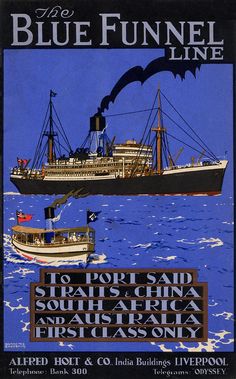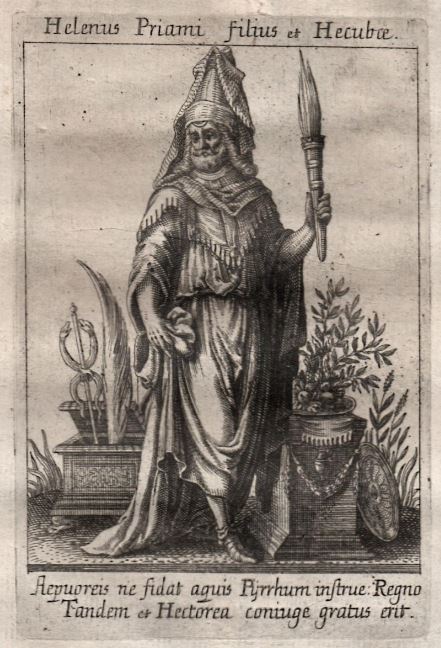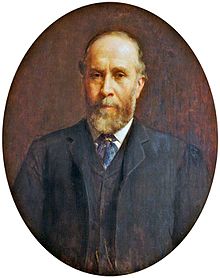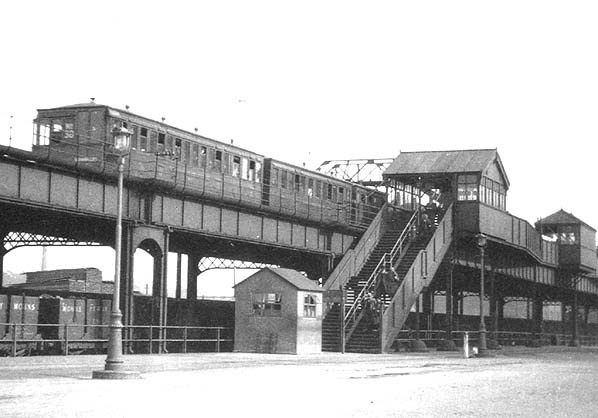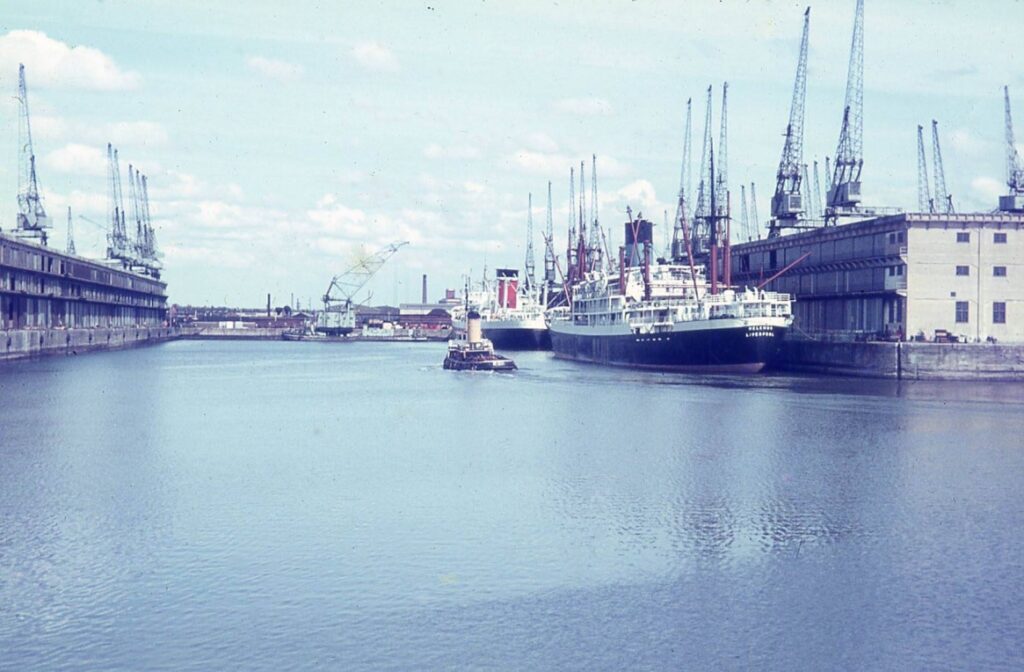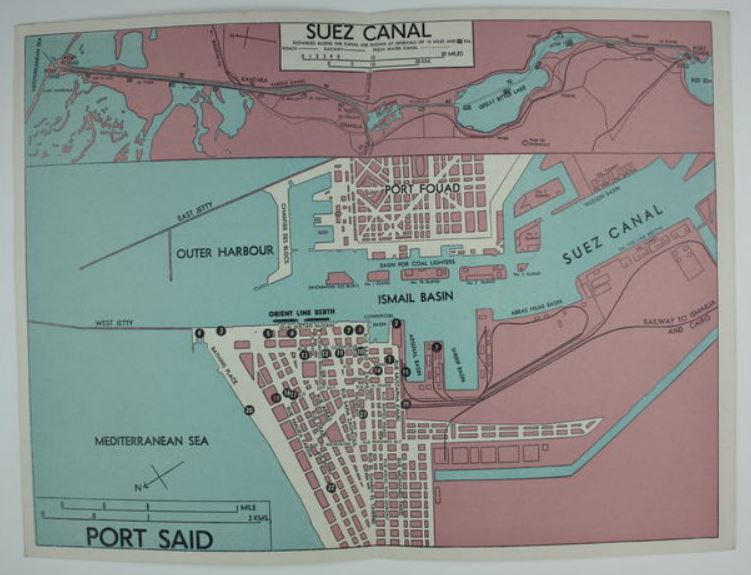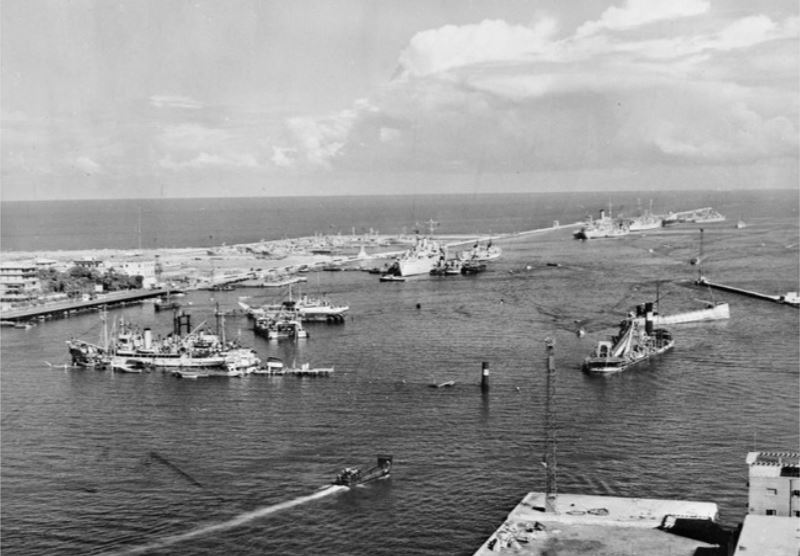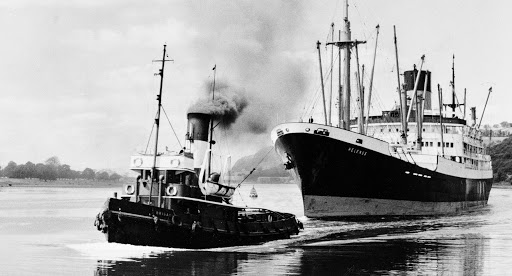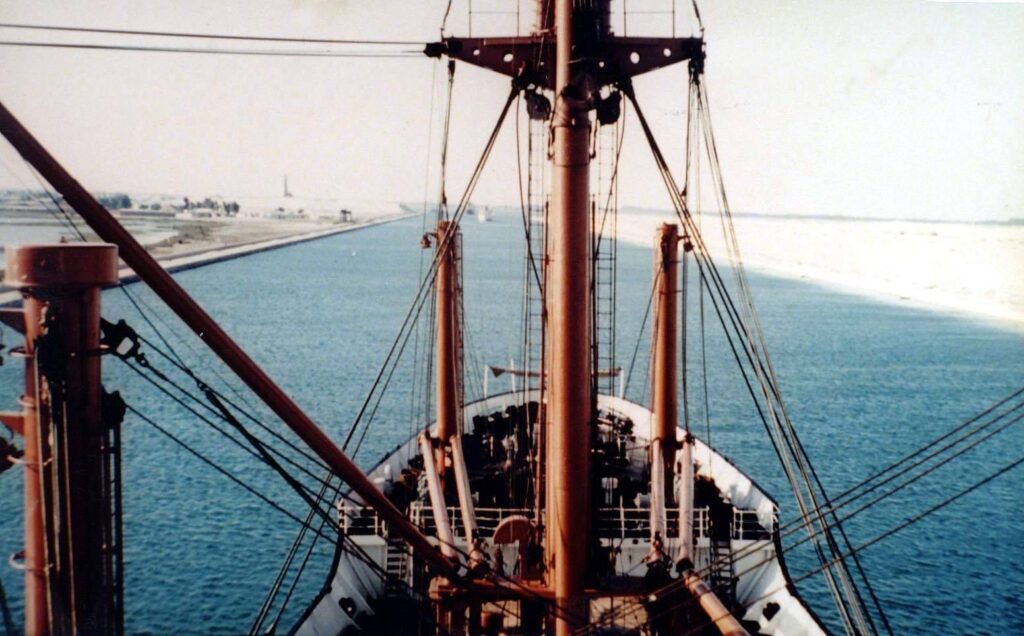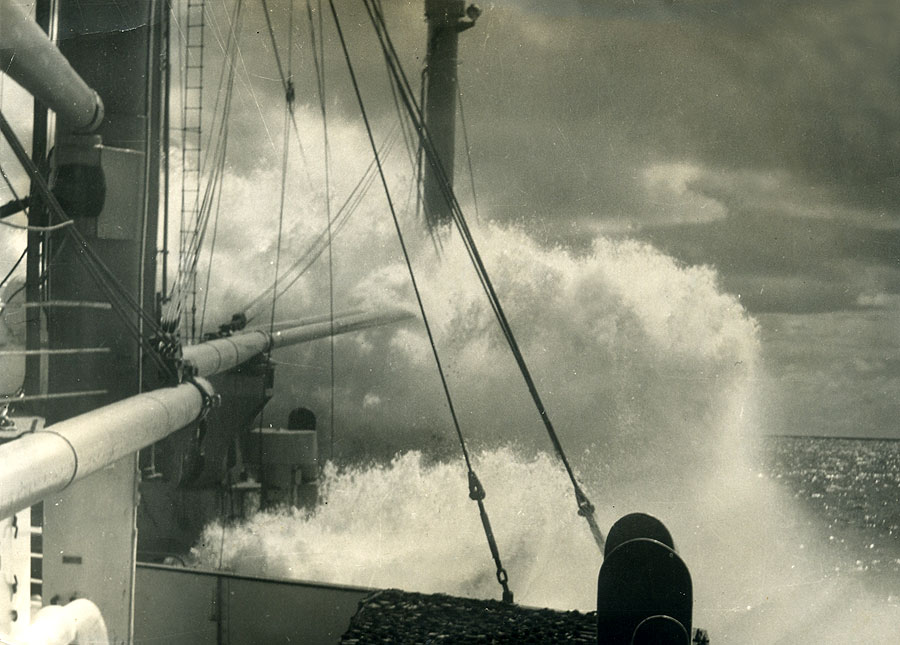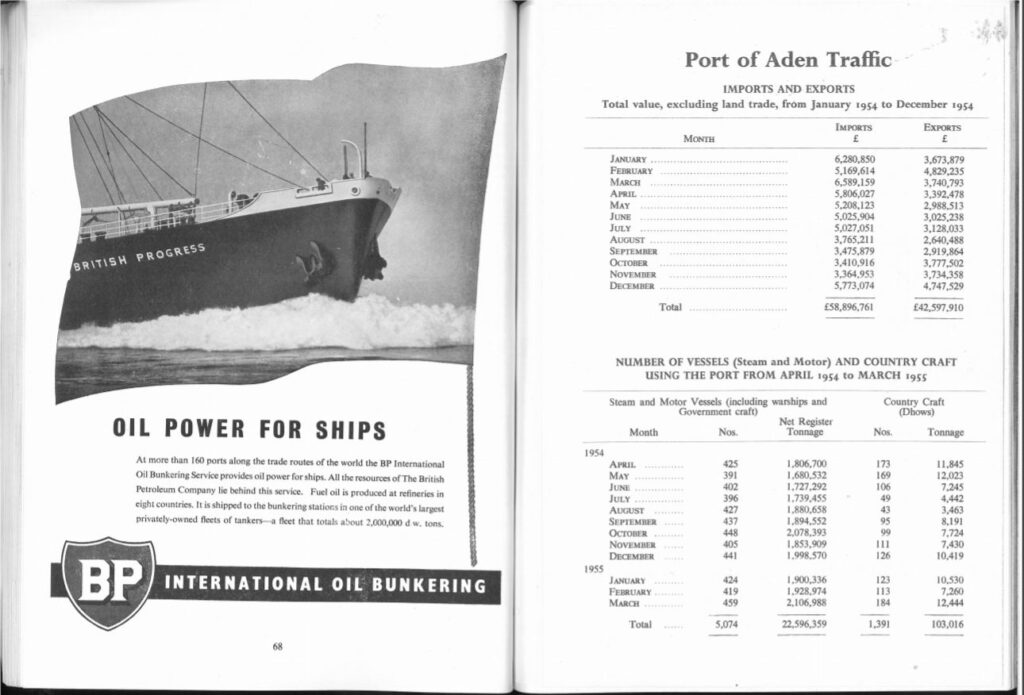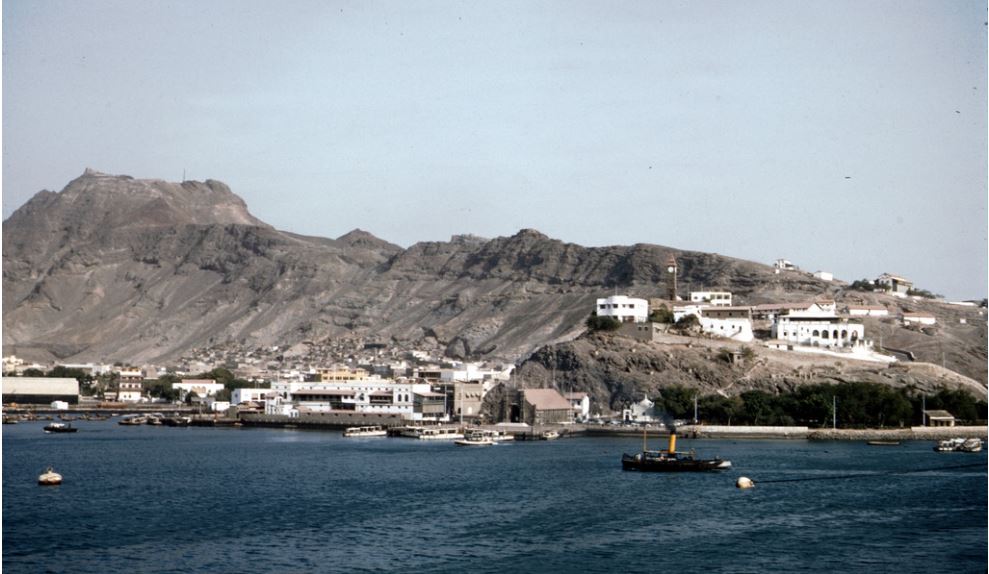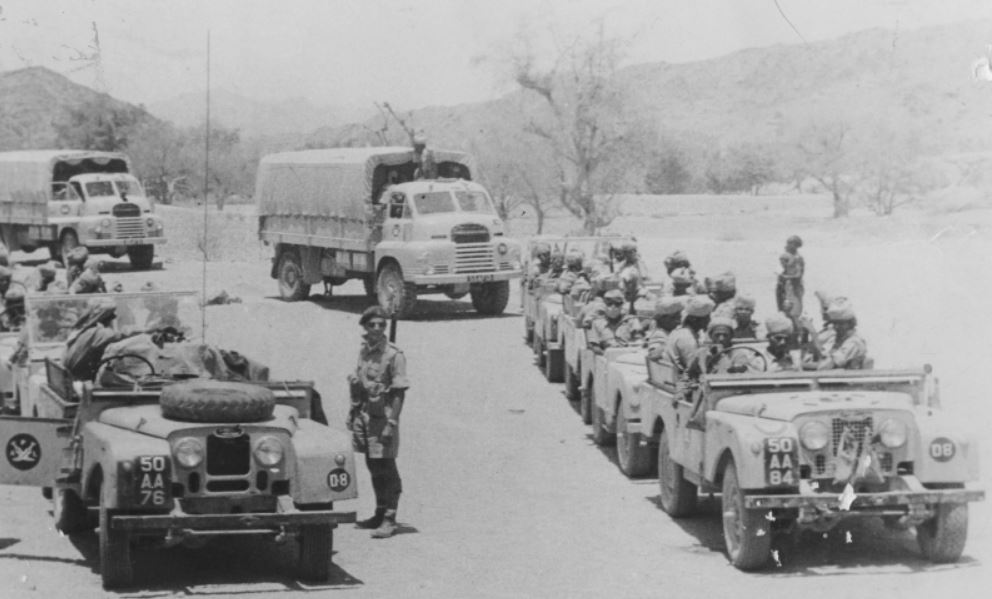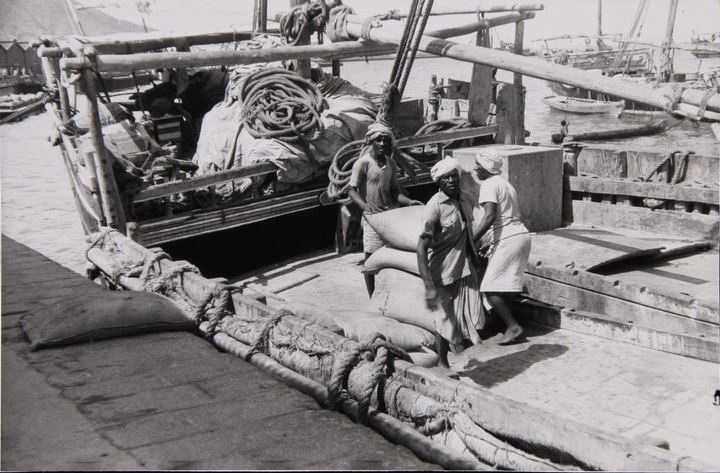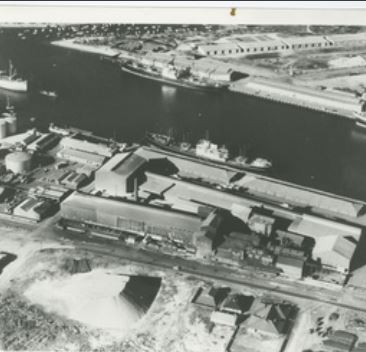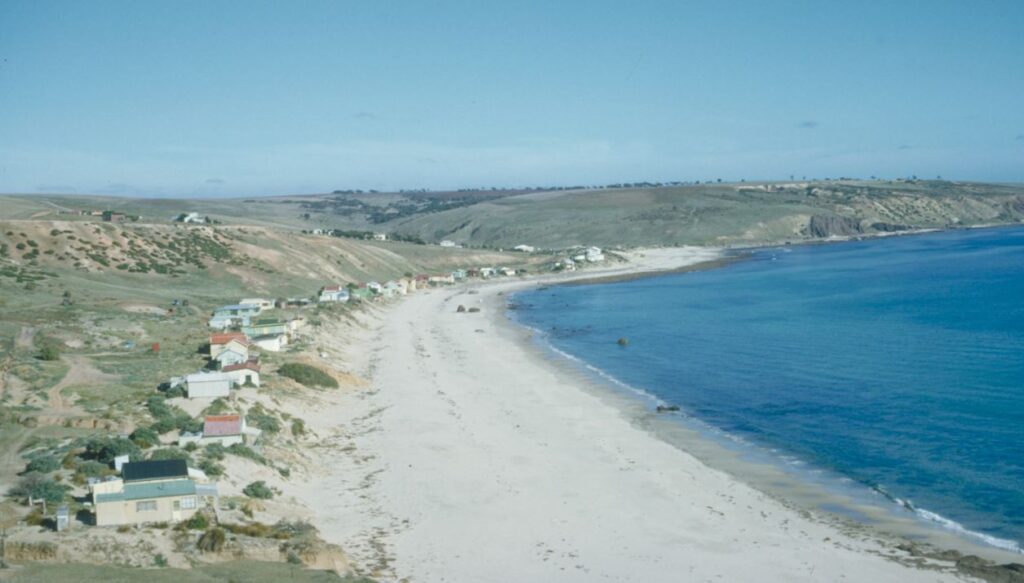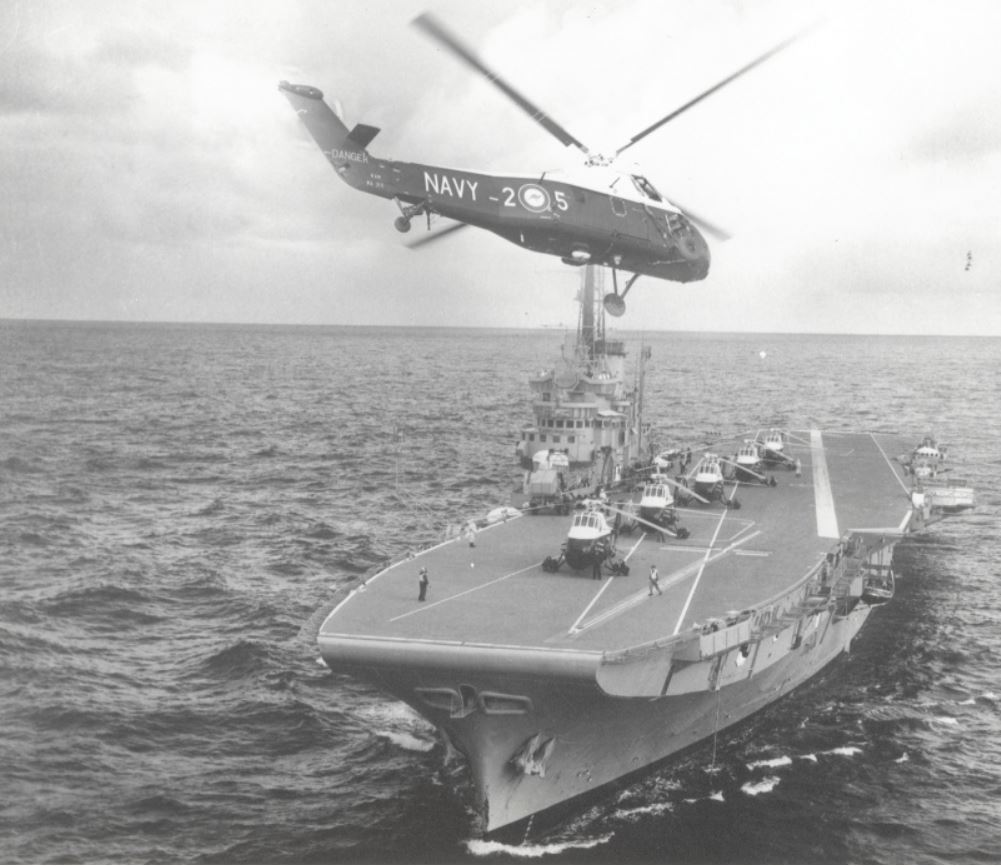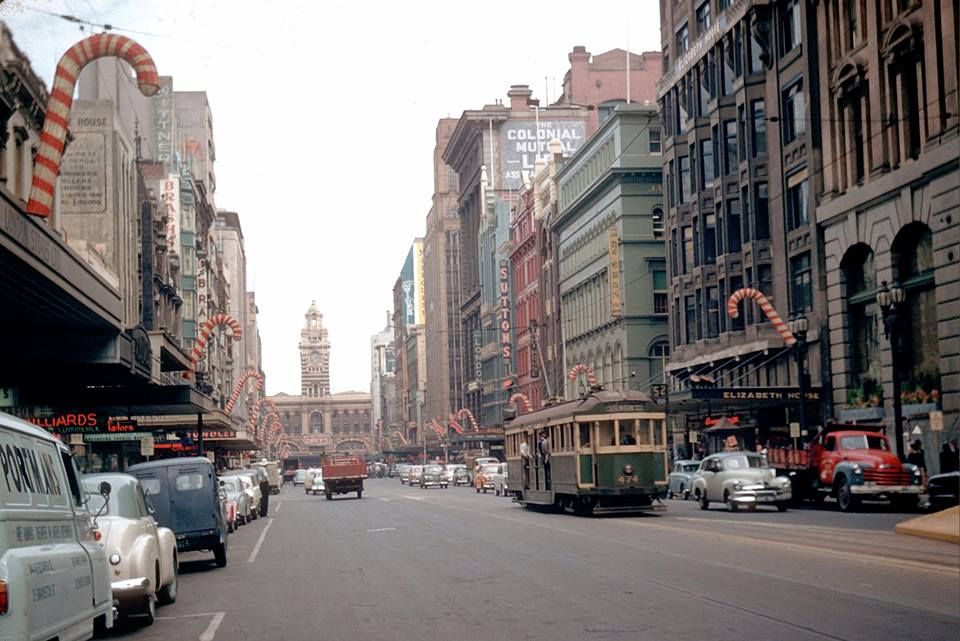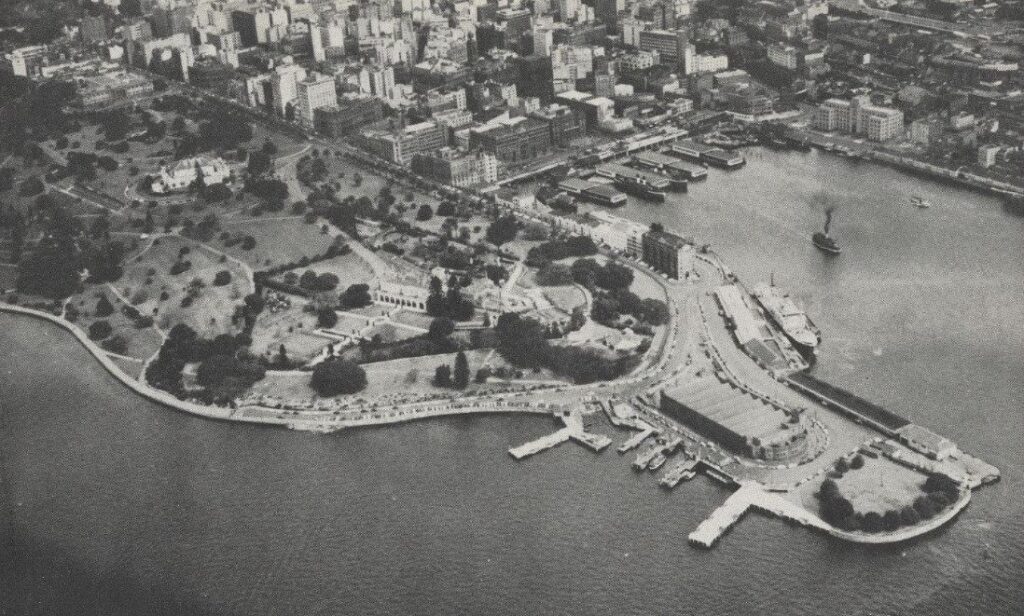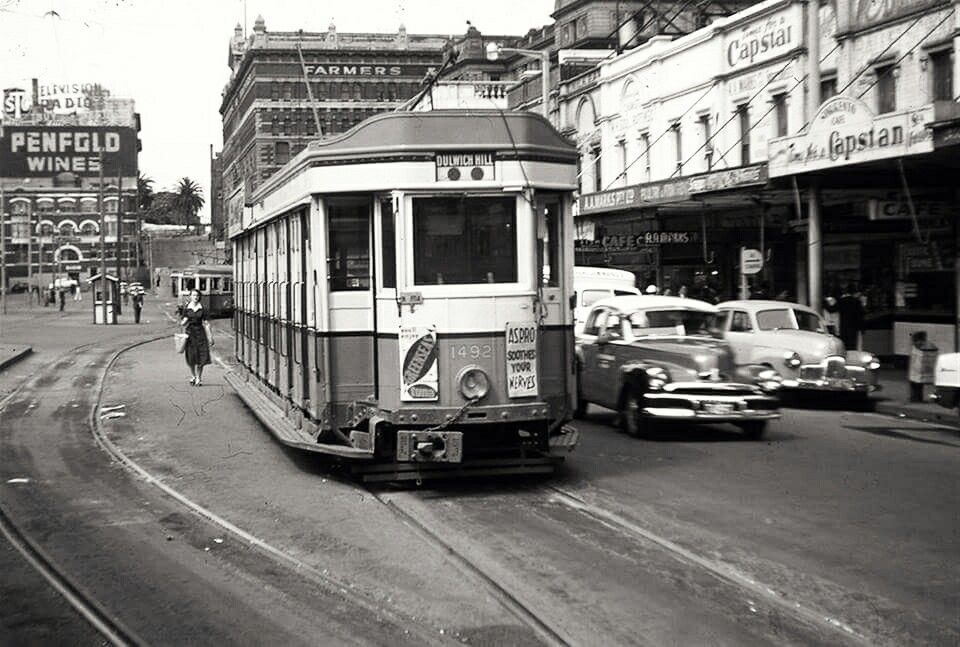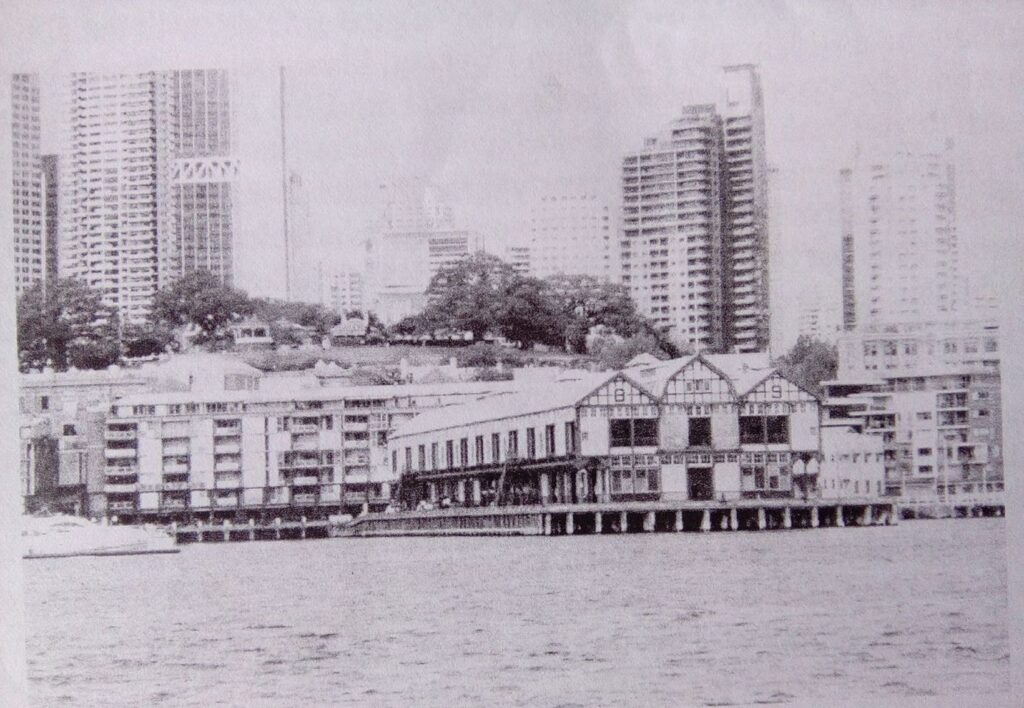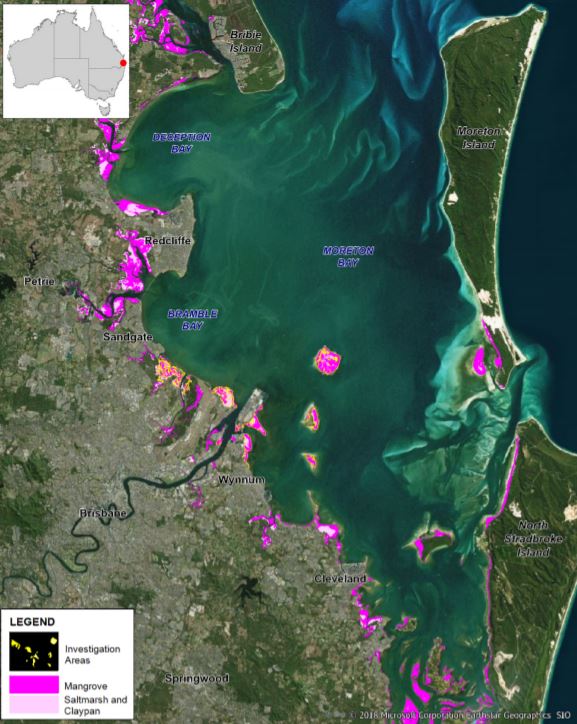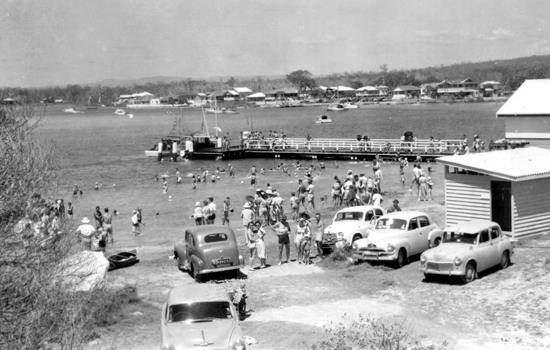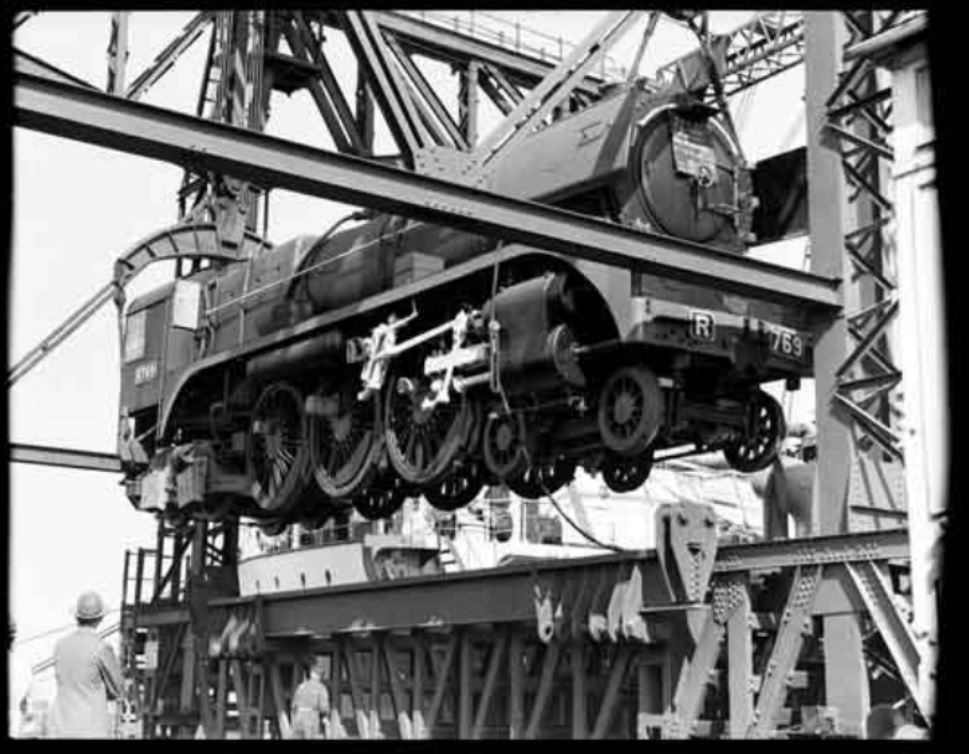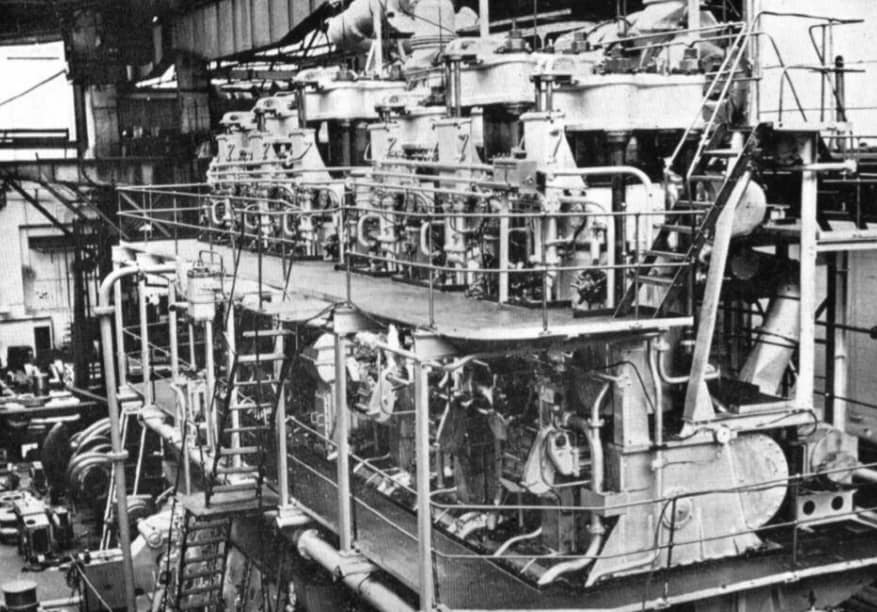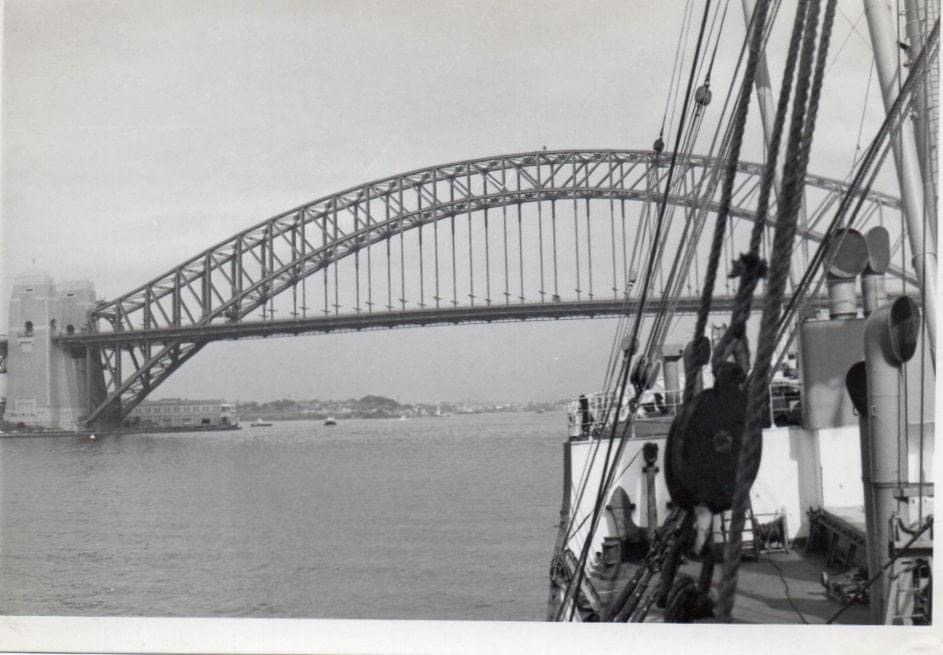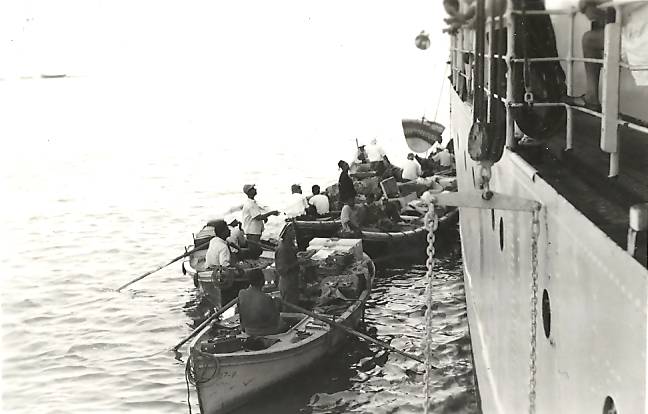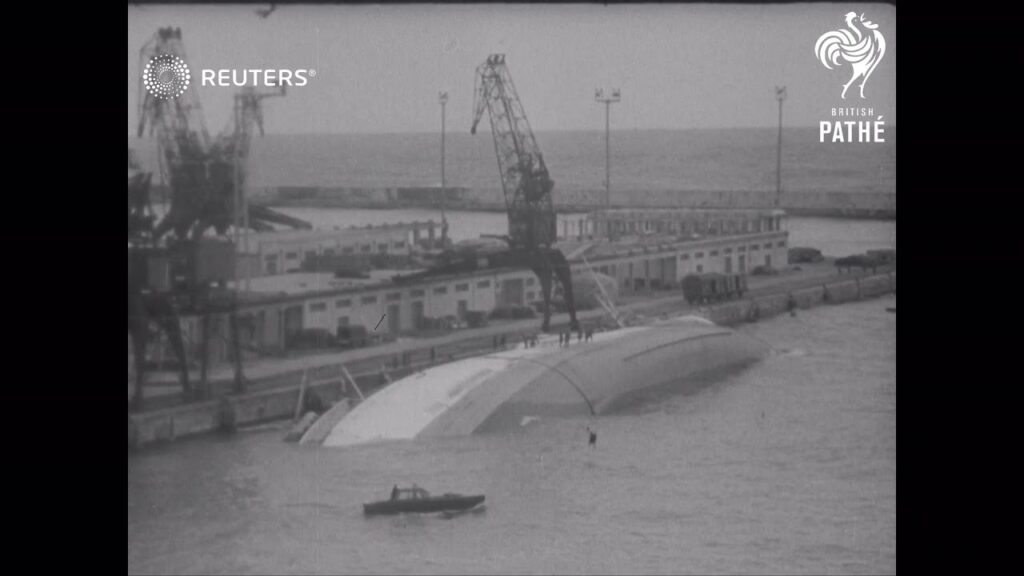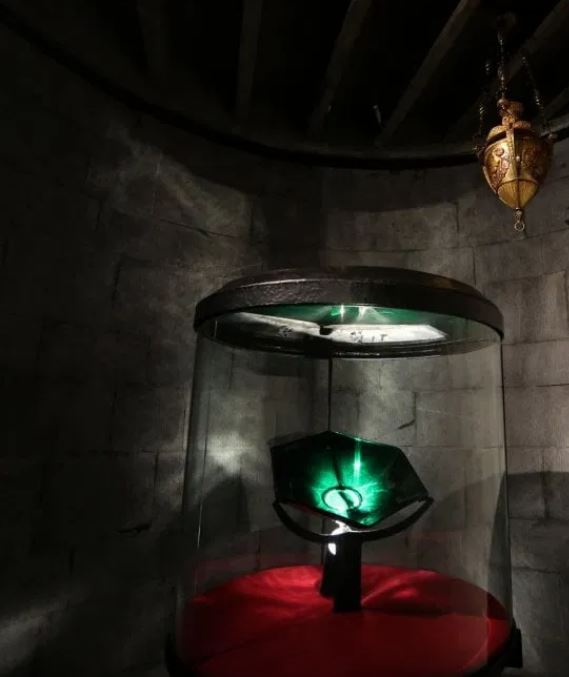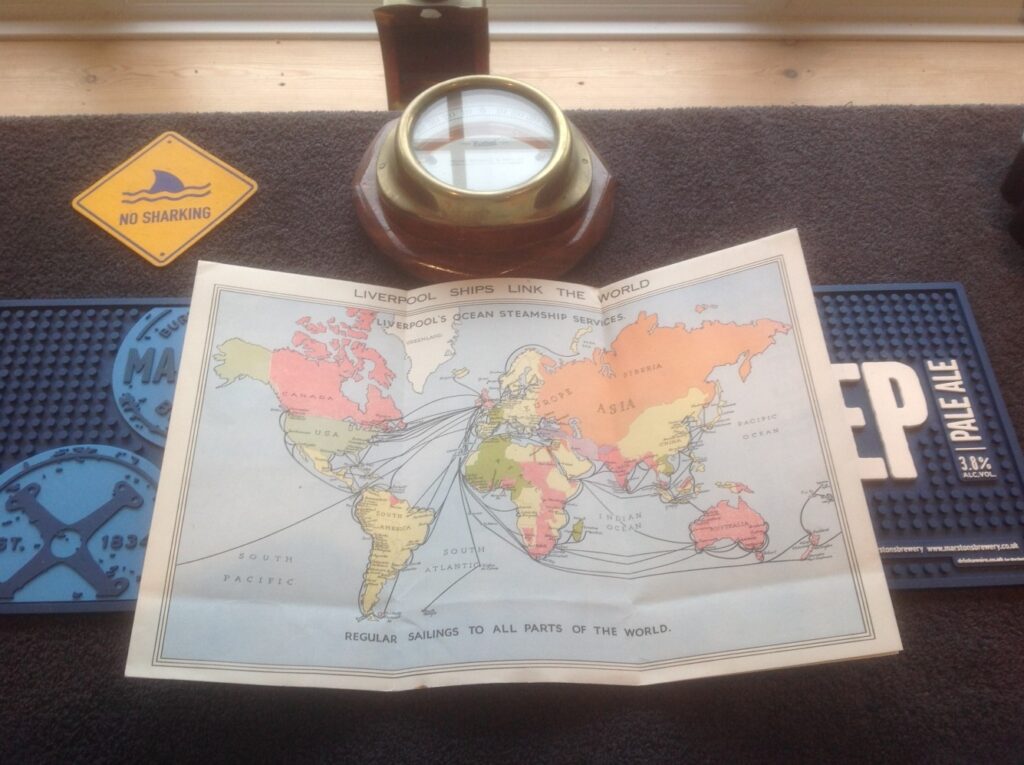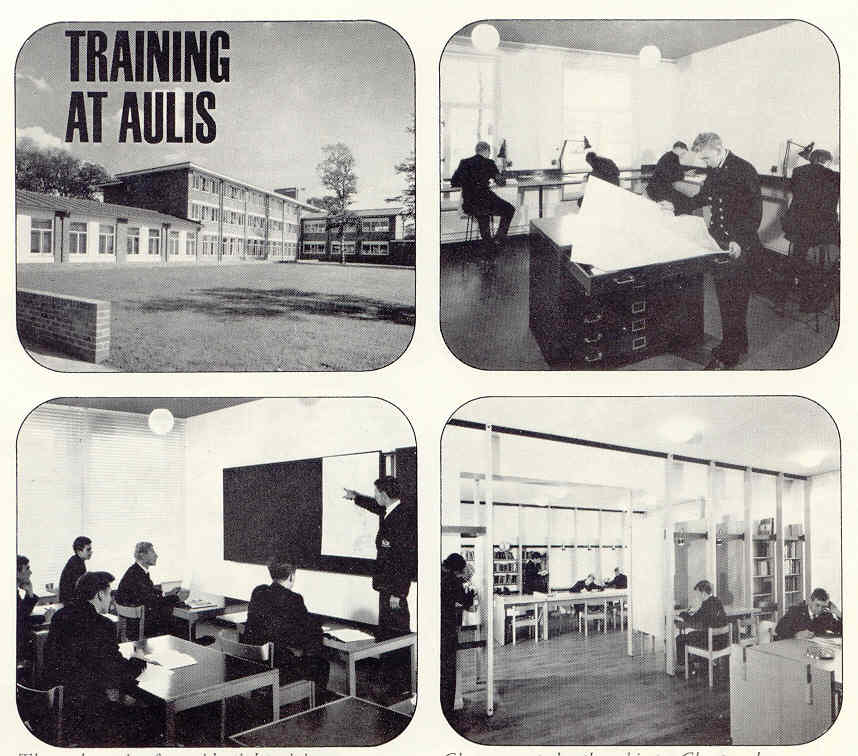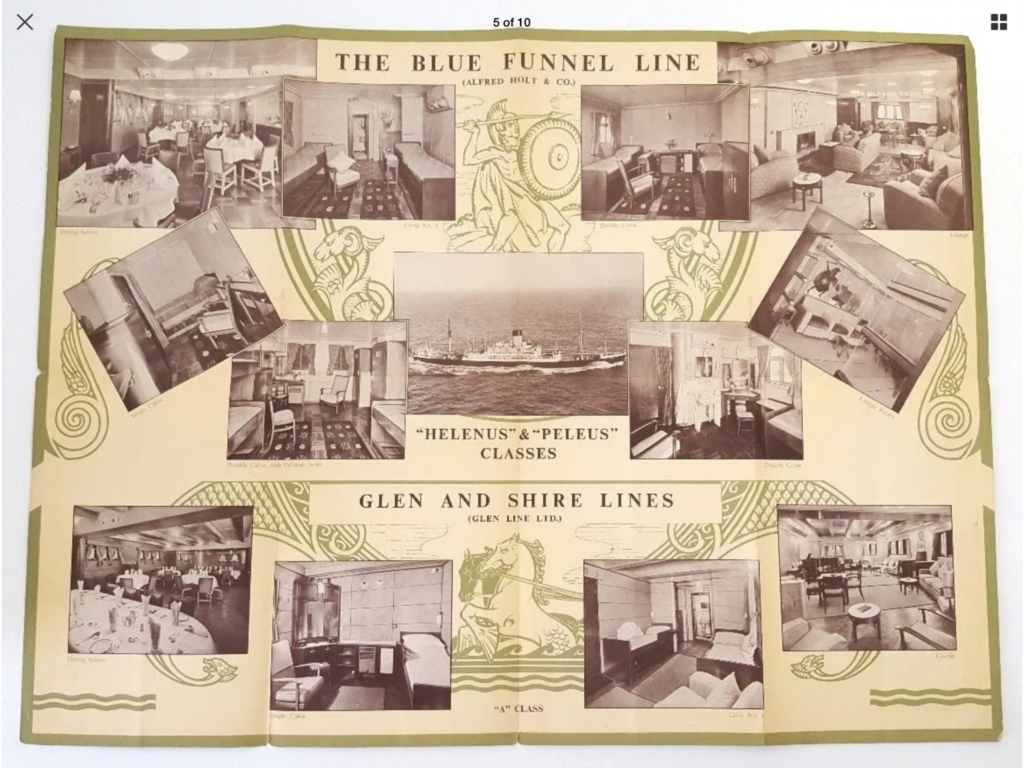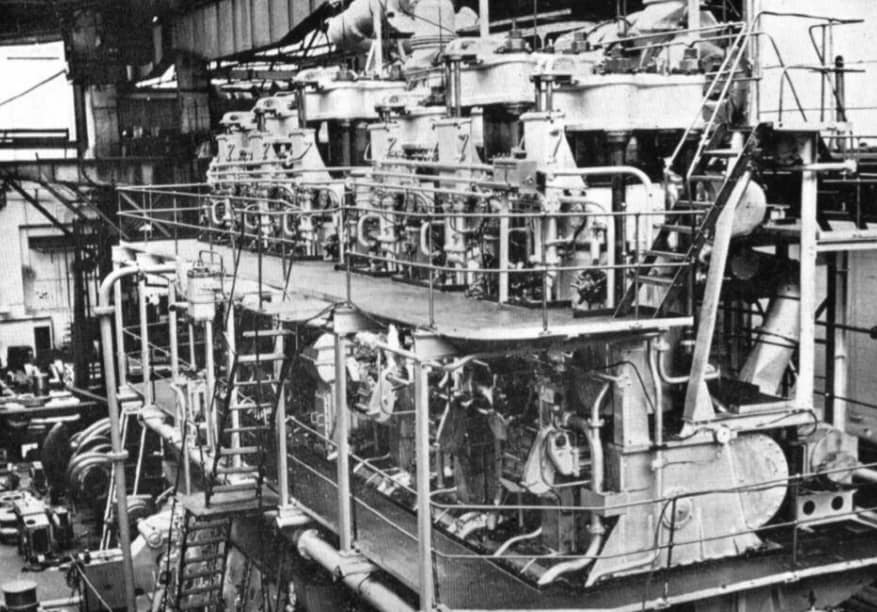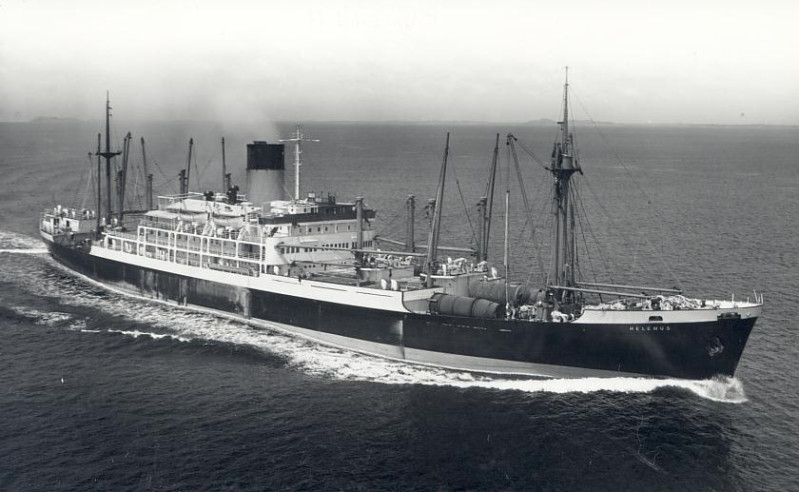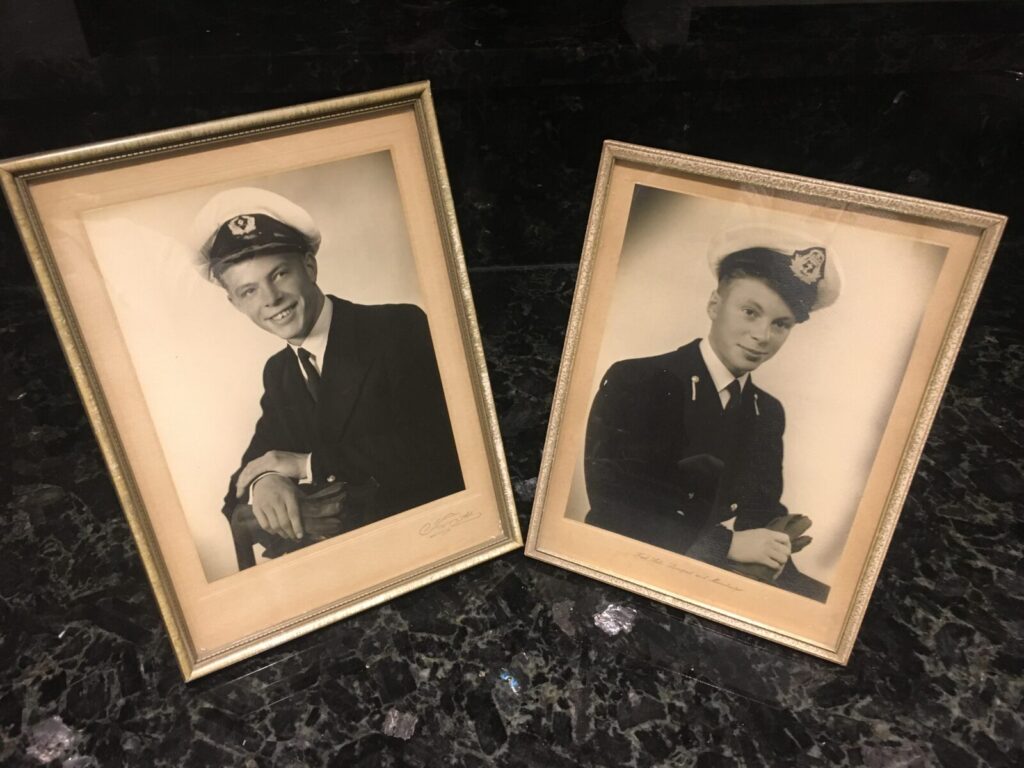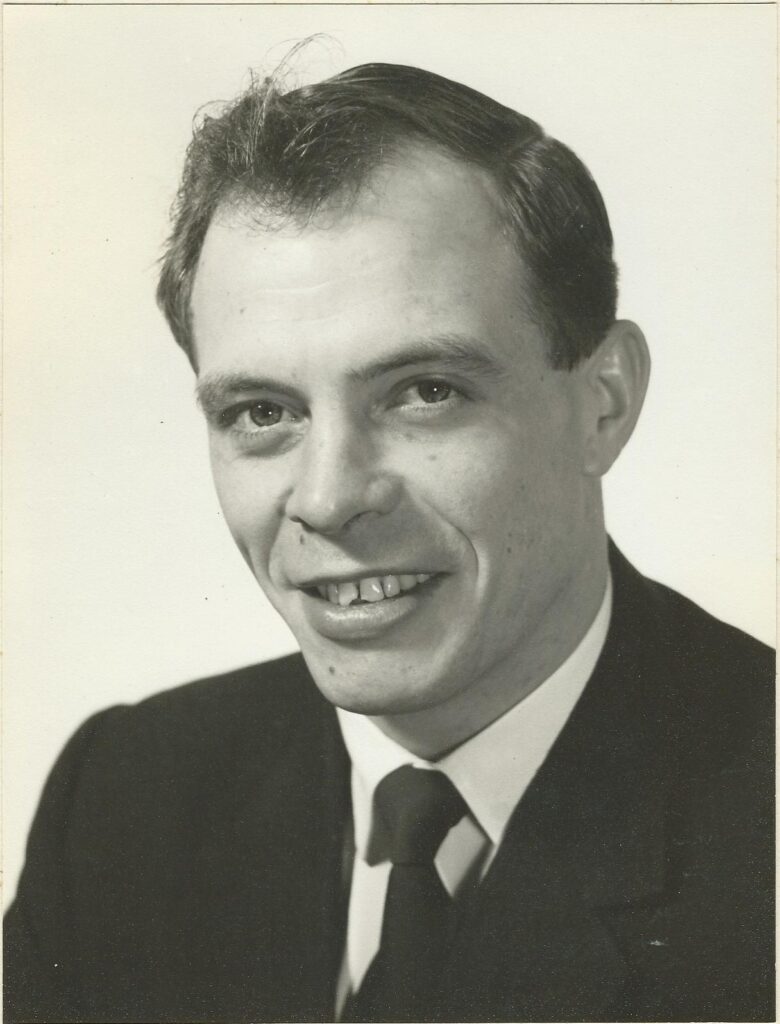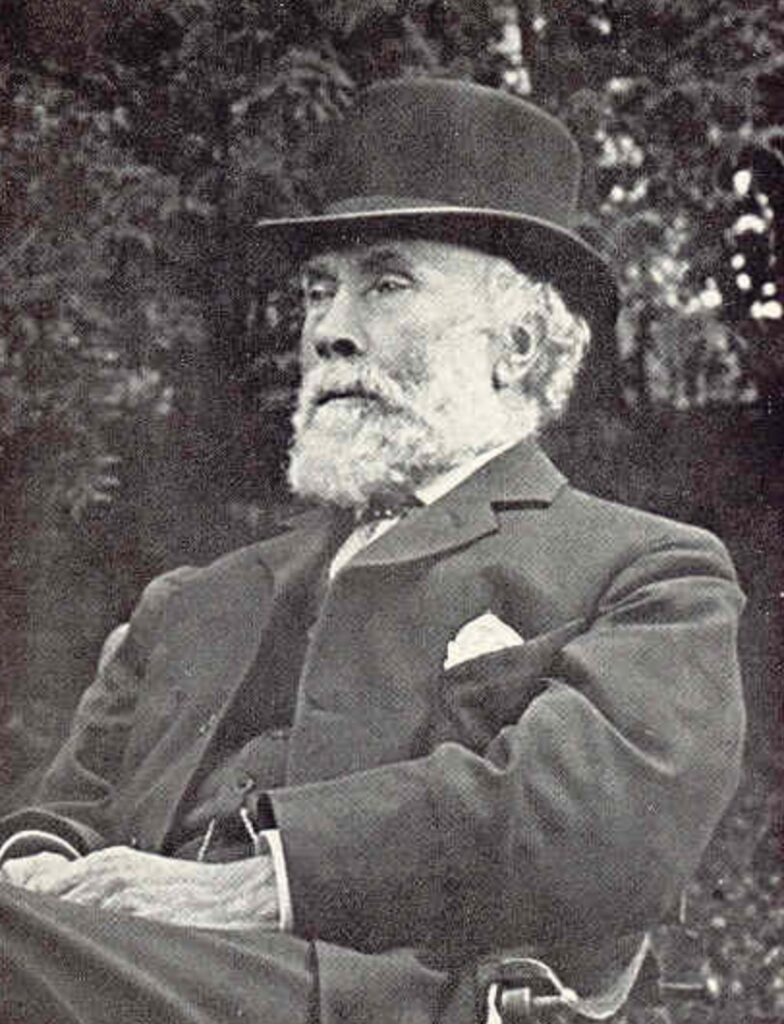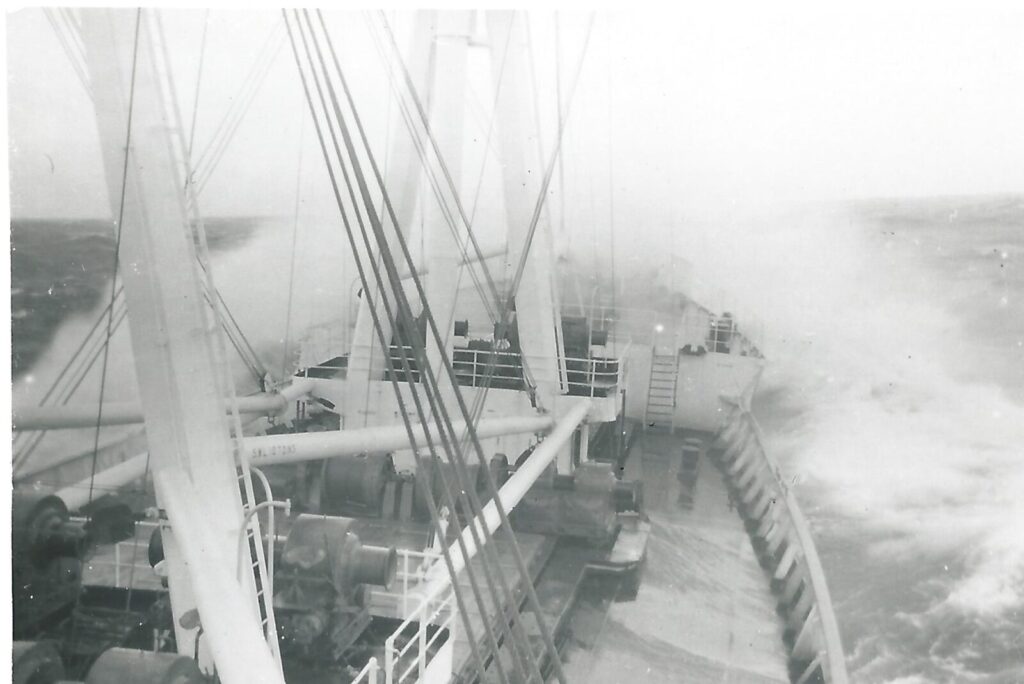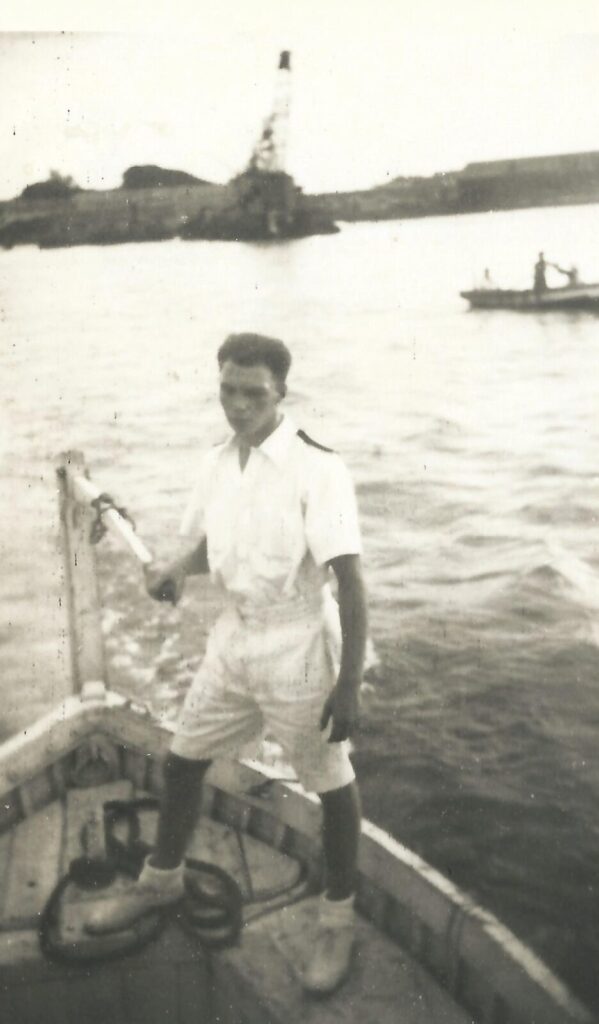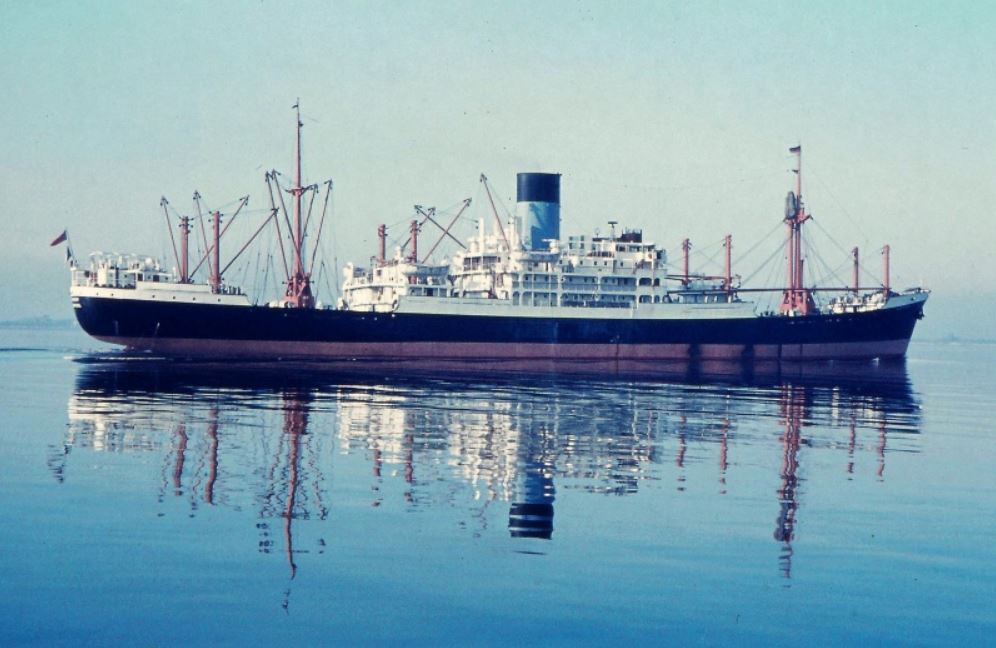
Dolius was brand new when my father joined her at Harland and Wolff’s Belfast yard, so new in fact, that her paint was likely still wet in places, Dolius was on her sea trials when Engineering Cadet Ian Jones and her crew sailed on the 03rd January 1956, Captain S. G. Ellams taking Dolius, and the high and mighty of the Blue Funnel line including Lawrence Holt, one of the owners, on her maiden voyage across the Irish sea to Liverpool, to load for embarkation on her first deep sea voyage. The crossing was an eventful one of sorts, fog making berthing Dolius in Vittoria Dock impossible that day, forcing her to anchor up in the Mersey estuary until the next morning, when the fog had cleared sufficiently to make docking safe
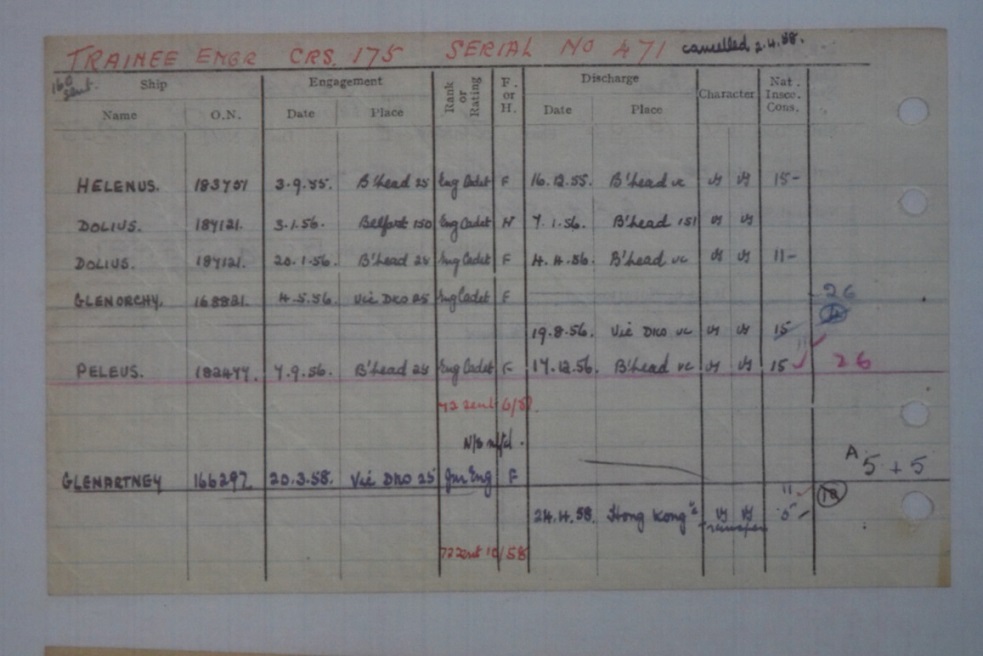
Dolius was a new variant of the Blue Funnel “A” class boats, designated, officially, “A Class Mark 5”, although ships of this class would eventually be known as “D Class” to the wider Blue Funnel family and workforce. So……. what was different then, to distinguish a Blue Funnel A Class MkV vessel like Dolius (the “common” classification ‘D boats’ was taken from the naming protocols, Dolius, Demodocus, Diomed…etc), from an A Class? The immediate giveaway is the position of the lifeboats each side of the rear of the Bridge and Passengers accommodation, and, on the D Boats, at the crew quarters known to the crew as “the sailors house”, aft (rearwards) of No 4 hatch (rhiw.com “The Blue Funnel Line “D” Boats” On-Line resource: rhiw.com/y_mor/blue_funnel_home/d_boats/d_boats/d_class.htm Accessed 08/08/2021). Then there was an additional (small) cargo hatch and two derricks (cranes) on the “poop deck” (the rearmost deck, at the stern of the ship), the bulwarks (the front facing panels of the bridge wings Port & Starboard) on the bridge wings were steel, while on the A Class they were wooden and the A Class Mk 5 ships were a little longer too, by around 5 feet

Dolius was a little “odd” in that her bulwarks were wooden at her commissioning and for quite some time after (until her name was changed to Glenfruin in 1970 I believe) when they were eventually painted White. To confuse things even more, several of the A Class Mk5 ships were given A Class names, Ajax, Achilles and Antenor….I believe Dolius was the last Blue Funnel ship from the Harland and Wolff Belfast Yard as her sister ships, both A Class Mk 5’s, Demodocus and Diomed were completed at Vickers Tyneside yard in Newcastle, fitted with six cylinder Burmeister & Wain Engines where Dolius was outfitted with a Harland and Wolff built unit
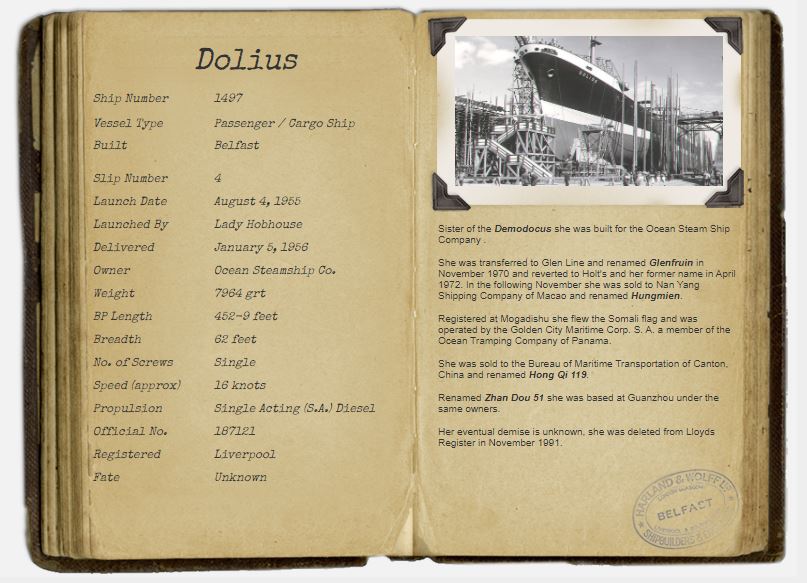
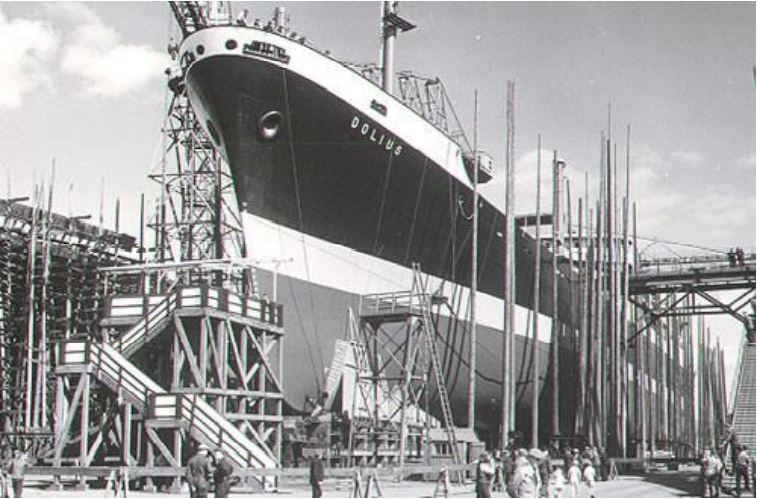
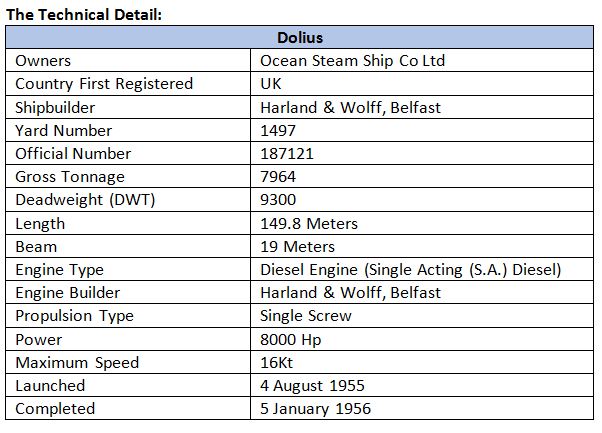

Ian Jones, now an experienced cadet, having returned from a successful trip on Blue Funnel’s Helenus to the far reaches of Empire and as far South as you might reasonably go, Australia, found himself with another prestige deployment, the maiden voyage of Dolius, brand new and of such importance that Lawrence Holt himself had undertaken the voyage to Liverpool from Harland and Wolff in Belfast. Dolius first voyage was under Captain W.K. Kerr, (a noteworthy marine artist apparently) on the bridge and well out of sight of Cadet Jones who would have found himself in Dolius engine room, far enough from the likes of Lawrence Holt and Captain Kerr as to ensure he could not become an embarrassment at such an early point in his career with the Blue Funnel line…. Deep in her hull Dolius carried a state of the art Harland and Wolff diesel engine, a six cylinder marine diesel unit known as a “single acting” engine
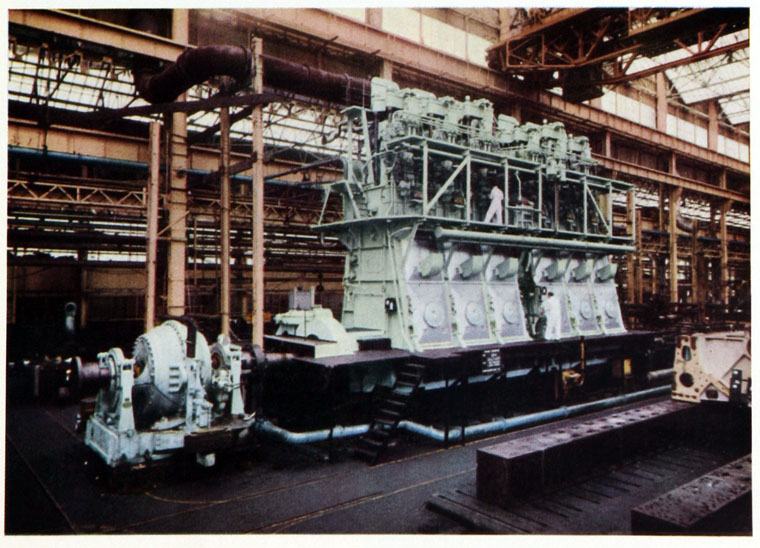
So what of her outfitting and the standards of the time, what would Engineering Cadet Ian Jones or one of Dolius Passengers expect when embarking on one of Alfred Holt’s voyages of discovery across the globe? In researching Dolius I was fortunate enough to come across the Harland and Wolff archive registry for Dolius and it contained an index of un-published photographs taken during construction and at and during her launch. I took the opportunity of getting in touch with the National Museums of Northern Ireland H&W archivist, Stephen Weir, to see if the photos could be accessed and if I could be allowed to re-produce them for this piece. After several chats across the ether Stephen agreed to send me some low resolution scans from which I could choose those photos I would want to include in the piece and H&W would scan and send them across. I must say I was probably a little too excited at this than any normal adult should be, I anticipated the photos with a kind of childlike expectation, somewhat akin to waiting for Christmas when you are 6 or 7 years old……..Anyhow, what follows is a set of photos that to my knowledge and that of Stephen at Harland and Wolff, have never previously been seen, I hope you agree, they were well worth the wait!

I have little idea who took the photos but likely they were a record of the last days before launch, they have the kind of look of an amateur from within the company or perhaps one of the company executives with the privilege of access rather than the “professionally commissioned” type of shot? I would be pleased had I taken some of these back in the day but they seem to lack that stark “polish” of a professional studio photographer or publicity type photo’s, if I’m honest, that makes them a little more “real” to me

In the 1950’s the austerity of the war years was slowly being replaced with the optimism of the baby boomer years, there was a move away from the restrained and a more laissez faire approach started to creep into fashion and that permeated slowly into furnishings and fittings, people wanted to see that the sacrifices of the war years meant something, that things would be better from that point and that restraint was no longer the way forward, there was an air of extravagance that by 1950 had become “modern”, new materials created out of the necessity of the war had new purpose, there was a rush to provide materials for re-construction and plastics and nylon derivatives had started to influence designers in Europe, keen to get back to international trade. The 1950’s were not quite the boom years, but they heralded the excesses of the 1960’s and laid the ground for huge shifts in style and design, some of that is evident in the fittings used in the Dolius, the furnishings and perhaps even extravagances of the cabin fixtures of what was, after all, not a cruise ship, but a merchantman

Alfred Holt and his Family had always ensured their ships were of a better standard than was considered “normal” for the day, there was always provision for passengers aboard the Blue Funnel Ships and accommodation was always of a more than comfortable standard to encourage perhaps the better of the travelling classes to join the Holt line aboard, for trips to exotic locations yet to be available on commercial airlines, but times were shifting, the war years had shown, if nothing else, that “time” was a factor in life, perhaps more so to the generation of the 1950’s than ever before

Looking at the style of the furnishings and fittings Dolius was appointed with gives the distinct impression of the influence of the Italian liners, there are not, perhaps, the extravagant inlay and marquetry panels of the Andria Doria, but there are extensive laminate wall and ceiling panels, the dining chairs show a rather stylish Leather and Lime-Wood or Light Oak back paneling, somewhat more than would have been usual on a merchantman of the day, but clearly in keeping with the Holt approach and definitely a move away from Spartan, the parquet flooring another rather expensive if not extravagant touch
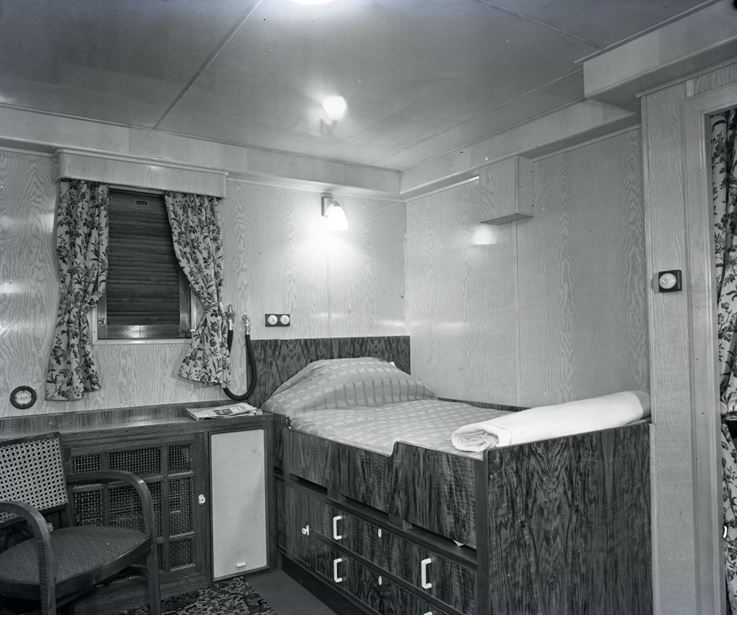
The Captain was taken care of too, everything I have heard in regards to the Masters of Blue Funnel ships speaks to the high regard the company had for them, Blue Funnel did not insure their vessels through Lloyd’s of London, choosing to put up the insurance entirely through the company finances, I believe the Captains were part of this inasmuch as they had a portion of their wages retained against a kind of performance bonus. The mutual trust implicit in such an arrangement cannot be understated, and, although I am sure Blue Funnel Captains were not without their faults and that this system would not prevent the odd incident, it certainly invested the Captain’s in their vessels and the company profitability, not surprising then to find the Captains cabins were, to say the least, comfortable!

When Dolius left the slip at Harland & Wolff’s Belfast yard, it was clear she was built with the expectation of the age, the anticipation of profitable commerce and maybe even more profitable provenance. Dolius price tag was a respectable, for the time, £1.45million and her owners anticipated a return on that investment in short order

So, Dolius is ready, her fit-out complete and her sea trials in Belfast Loch and out to the Irish sea underway, she handles well and is quickly passed off for service and makes her way across the Irish Sea to her home port of Liverpool taking esteemed guests such as Lawrence Holt, one of the owners of the Blue Funnel Line with her, and now Engineering Cadet Ian Jones and those in the belly of the ship get to test her engines…….
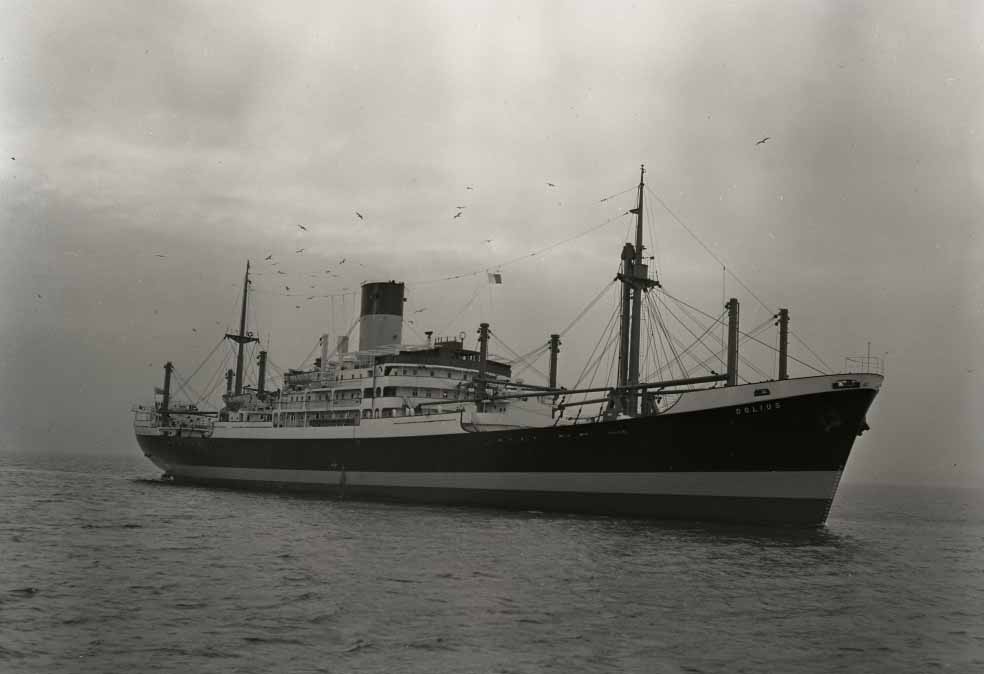
Dolius first trip across the Irish sea would not be entirely without incident, on approach to the Mersey Estuary there was fog, so dense as to make it impossible to dock, Lawrence Holt seems to have taken this in his stride, radioing ahead to advise those expecting her to dock to inform them of the delay and a night at anchor out in Liverpool Bay
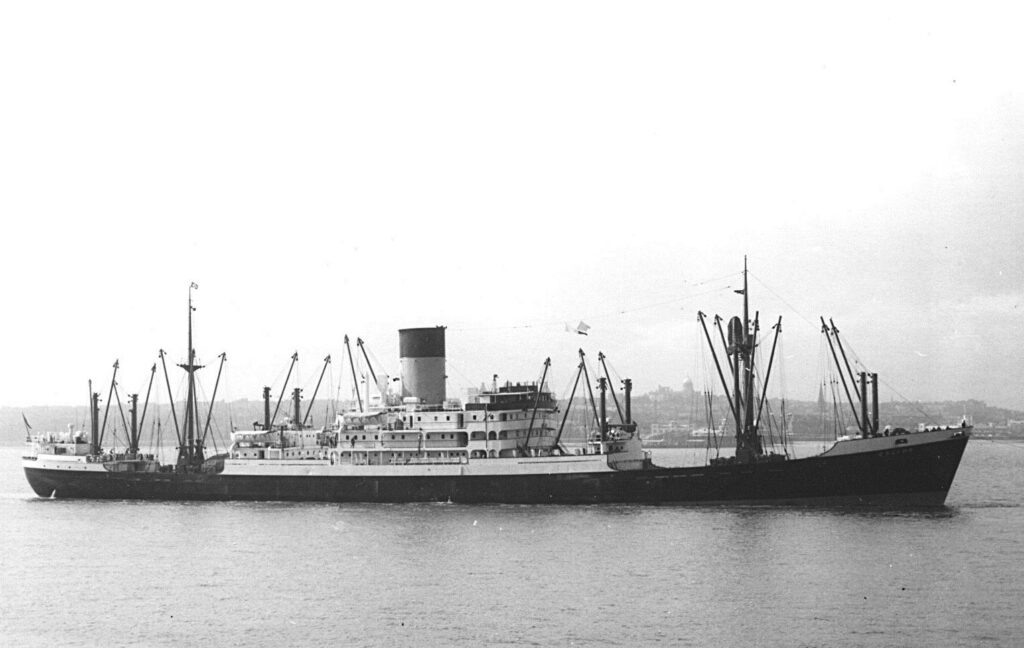
It was not long before Dolius was put to serious work, a change of Master to S.G. Ellams and a departure from Birkenhead on January 20th, at 11.39pm, a precise time, recorded in her Journal held in the archives in the Albert Dock museum for Liverpool Maritime Museum. For anyone with an interest in the Blue Funnel Line, their ships or their associated shipping lines, Elder-Dempster, Glen-Line or The Ocean Steam Ship Company for example, a trip to the Archives on the second floor of the Liverpool Maritime Museum is a must! It’s a little hidden, being in an alcove at the top of the stairs, but it is a treasure trove and the archivists are extremely helpful and very knowledgeable, as I found out on several visits, the last in early February of this year (2022) when I was researching this piece
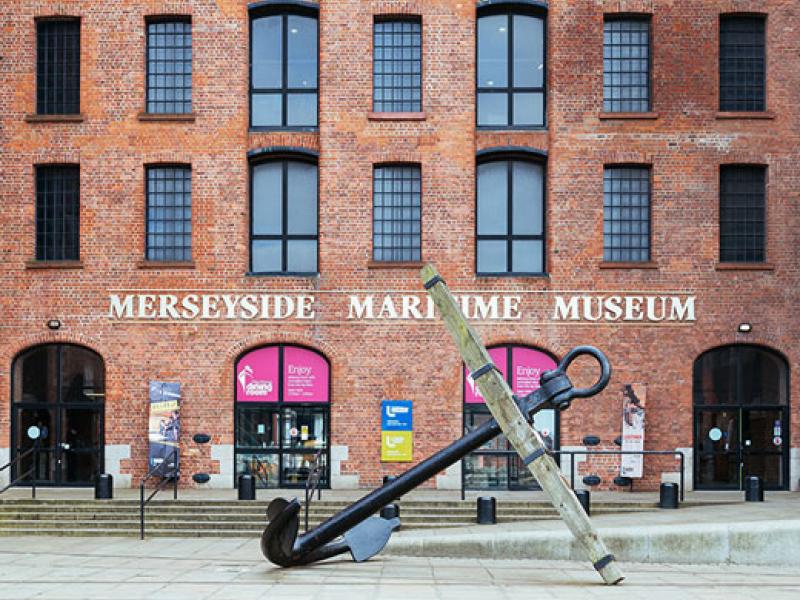
As research is not something the whole family perhaps enjoys, the museum itself is a fascinating place with many ships models and historic displays through the ages of sea travel & conquest, and there are many maritime related pieces around the Albert Dock. Lusitania’s prop, one of three that drove her deeper into the sea off Old Kinsale Head, thwarting attempts to lower her lifeboats in 1915, sits across the dock from the museum. There are also several merchant and marine memorials for those lost in WWII, and for those who remember merchant navy training, the exhibit at the entrance is the anchor from HMS Conway. HMS Conway was a three masted ship of the line, formerly HMS Nile, once moored in the Menai Straits as a training college, which co-incidentally, my Uncle Keith, Ian’s brother was trained on. Sadly the Conway broke her tow, 14th April of 1953, en-route to Birkenhead (for a scheduled re-fit) following a poorly executed, and weather affected exercise to get her through one of Britain’s most treacherous tide-races. HMS Conway, a veteran of the Crimean War, ended up ashore badly damaged, and, before anyone thinks it, Conway was not insured. Some three or so years later, in October of 1956 she suffered fire damage and was declared a constructive loss, I can find no cause listed for the fire but its results were both fatal to HMS Conway and a tragic loss to maritime history
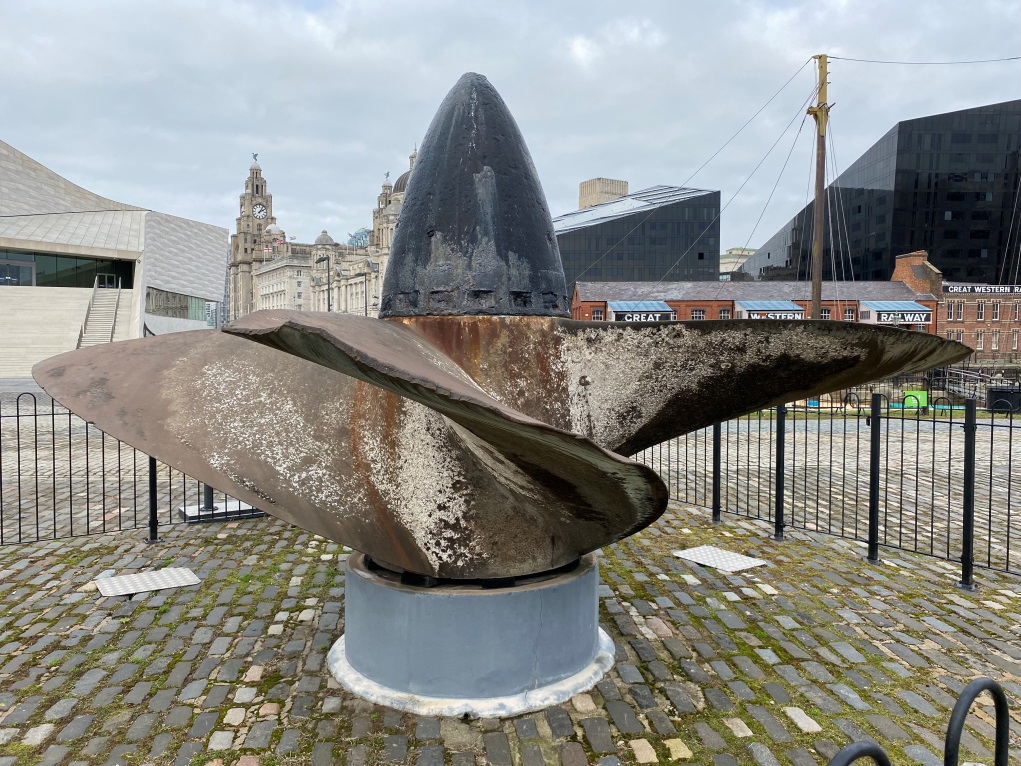
So, with shiny new paint, and all systems up and running, with sea trials complete and with Cadet engineer Ian Jones down in the huge engine room, all that was left to do was to take her to sea….and what a journey her first would be! Master S.G. Ellams had orders to take Dolius to the Far East, Singapore in fact, and she would get there via the Suez Canal, a journey my father had already made on his own first outing on Blue Funnel’s Helenus just a year before…….That’s written up in another post on here if you have an interest……

Dolius would be taking Engineering Cadet Ian Jones back to some of the places he would now be familiar with, and perhaps a few more he would eventually become familiar with, and speak of in terms you knew hinted he’d had quite a time in too! I was far too young to understand where dad was getting the amazing toys we would see in my childhood, a pump action gun that fired ping-pong balls was one of my favorite’s and springs immediately to mind, if for no other reason than it was responsible for breaking at least one porcelain ornament my mother clearly loved (and perhaps my father did not…..?), I can remember that scene very well! But in later years when, perhaps, I should have been asking about Dad’s voyages and his experiences, it would not be straightforward, as often is the case, I was one of those willful teenagers with an attitude and I missed the chance through the angst and anger of trying to grow up…..
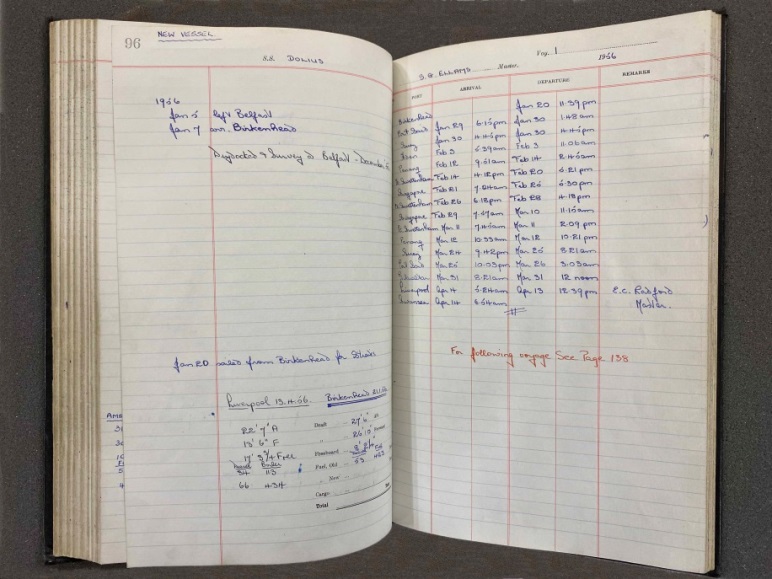
When Dad was growing up he did it in style, how many teenagers get the chance to see the world, how many of those do so training with Britain’s premier shipping line…..and I bet even fewer got to see the world’s most exotic ports and the countries and people that such places are owned, run and frequented by. So Dolius had taken him from Ireland to Birkenhead, and now out into the oceans of the wider world to re-visit Port Said as January melted into February of 1956, and transit Suez via the canal, reaching Aden 03rd February, and with tensions rising in the area times were increasingly dangerous and it was probably a relief to see the back of Aden and move on to Penang
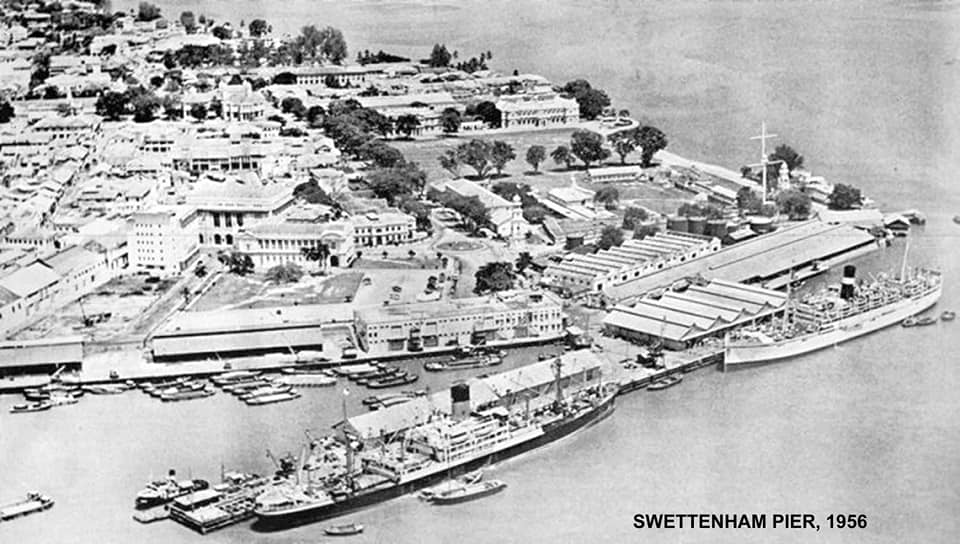
Penang was a British Malayan dependency, first acquired in 1786 following the establishment of a favorable relationship with the Sultan of Kedah by Francis Light (later Captain Francis light) of the British East India Company in the late 1770’s. Kedah was under threat from Burma, Siam, and the Bugis (supporters of local dissidents in Kedah), Sultan Abdullah Mukarram Shah welcomed the help of the British to establish a force in the area, offering Penang Island as a base for such endeavor. It would not be until 1786, when British involvement in the war against the emerging independence of America (allied with the French and Dutch against British rule), that Britain and the East India Company would officially land on Penang and raise the Union Jack, eventually building a fortified settlement (Fort Cornwallis) and George Town, named after King George III (Editorial “The Founding of Penang” Online Resource: http://www.sabrizain.org/malaya/straits1.htm Accessed 06/02/2022). Despite an invasion by the Japanese in December of 1941 and occupancy there until the later part of WWII (The Royal marines Liberated George Town from the Japanese in September of 1945), the British maintained control of Penang until just a year after Dolius visit when, in January of 1957, George Town was granted City status by Queen Elizabeth II
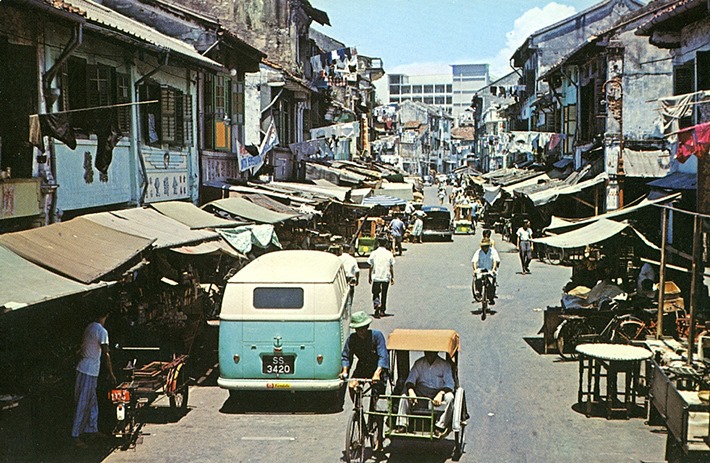
It would be Port Swettenham, the Docks of Penang that Dolius would reach 14th of February 1956, just two years after Penang exports topped the one million tons mark (Editorial “The Story of North Port” Online Resource: https://thehub.mmc.com.my/Q1/page52.html Accessed 06/02/2022) forcing the construction of a new deep-water port, christened Northport, and prompting the creation of the Swettenham Advisory Board (PSAB), but Dolius would unload from the traditional dock shown above, later known as Port Klang after the Klang river which forms the bay estuary

Likely the first port of call once unloading or cargo transfer had been squared away would have been the seaman’s mission, a popular stop off for the Blue Funnel crews, as was the City of Light dance hall. Dolius was in dock at Swettenham for several days between 14th Feb and 21st Feb 1956 (when she docked in Singapore) so there would have been some time to explore Penang at least and it wasn’t a huge area then, and certainly the port and surroundings would have been accessible, even if shore time was tight

Penang’s favourite haunt, the Hong Kong Bar was run in 1956 by Neoh Sze Hoon & Hong Kee from 1953 (although it had been open since 1920) after their escape from China in the communist uprising, their son Tan (Known as Peter by the Blue Funnel Crews) took over running the bar in 2000 when his mother Neoh passed away (Tan’s father, Hong, having died in 1993). The Hong Kong bar still exists (for those of you lucky enough to visit the area), despite a devastating fire in 2004 that all but destroyed it, and all the shipping and military memorabilia that hung its walls
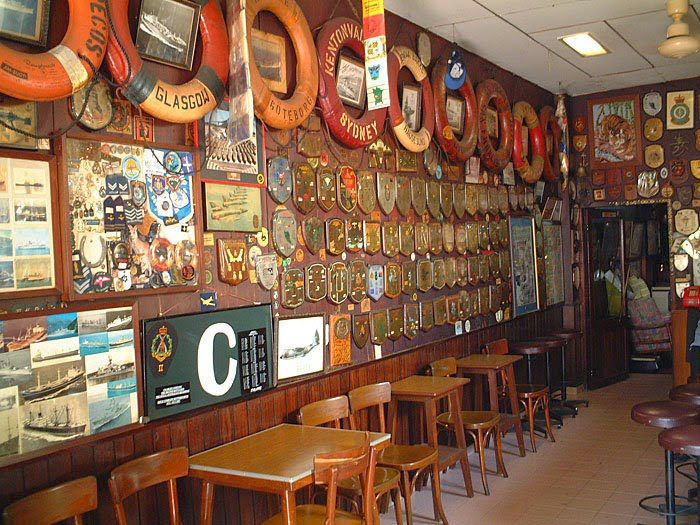
The Hong Kong bar has thankfully undergone a complete refurbishment, and some of the wall decoration survived and has been included in the current décor, it is nice to see both the recovery and the ties to history made by the owners as much as it is to anticipate a Tiger Beer or two at the bar one day perhaps……..
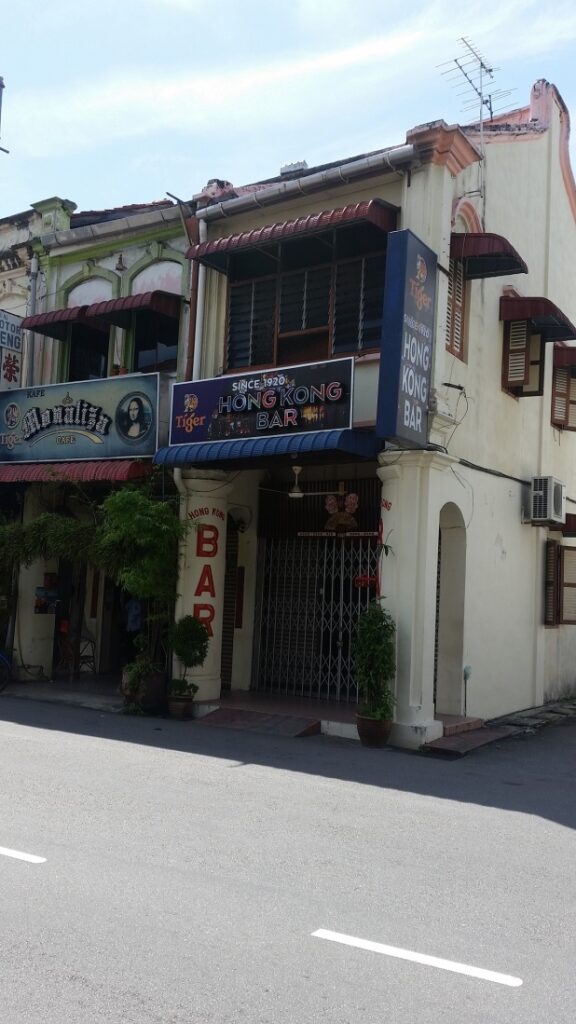
By February 14th Dolius had left Port Swettenham and moved on to Singapore (not a long journey at 414 (nautical) miles), passing Kuala Lumpur and Malacca City along the Malayan peninsula in what was known as the straits of Malacca. I am sure Dad would have loved the opportunity to stop in Kuala Lumpur if nothing else just to say he’d been there, but the sights of Singapore would have made up for that. Singapore started as a fishing village on an island at the tip of Malaya, known then as Temasek (“Sea Town” in Javanese), situated between the Singapore and Kallang rivers, it was nondescript and typical of a thousand other fishing villages in the area, but well placed and, as most fishing villages are, possessed of a reasonably deep and sheltered estuary
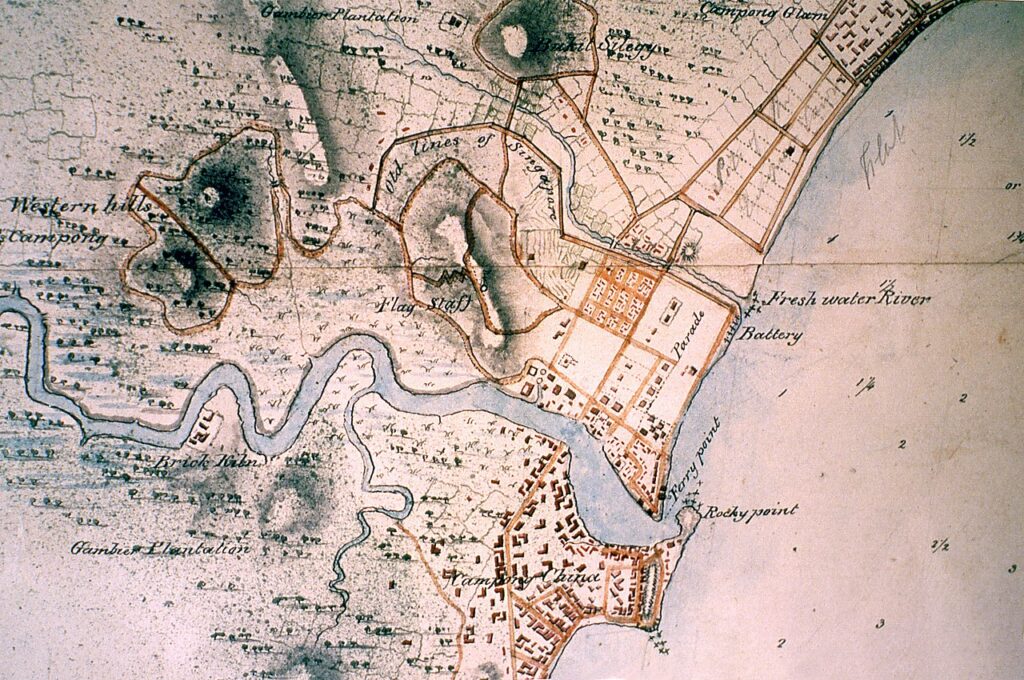
When Thomas Raffles landed on the 28th January of 1819, in that most adventurous of ages leading to and encompassing Queen Victoria’s reign, perhaps it was only he who could see the potential the little Singapore River’s fishing village with its protective rocky outcrop sheltering its wide bay at Ferry Point, and its ready access to Malay and Asian trade routes both on land and by sea

The trade routes of Asia and the East India Company of Thomas Stamford Raffles ensured Singapore flourished as a trade port, it would be the captain of HMS Meander, Henry Keppel who discovered a deep-water anchorage further around the river in 1848, whilst tasked with clearing the Malaccan straits of pirates, Keppel would have the bay named in his honour and established a new harbour there completed (following his survey of the area) in 1886 (Editorial “The Story of Keppel Bay: Captain Keppel” Online Resource: https://www.roots.gov.sg/stories-landing/stories/the-story-of-keppel-bay/story Accessed 07/02/2022). By the 1920’s, with Japan clearly looking to build its empire following its assistance to the Allies in WWI, Britain had decided to strengthen its hold of the Far Eastern trade routes and build a naval base there, although delayed by a change of Government, the base was opened in 1938 by the High Commissioner for the Malay States, Sir Shelton Thomas

Those of you familiar with the site will have seen the reference to bum boats before perhaps, if not they were the local skiffs which rowed out to trade with ships at anchor in the bays of the Asian ports, often filled with what would now be called tourist “tat”, but in the day they traded the latest radio’s from Japan & China, watches, clothes, beer, spirits, cigarettes, wild animals (occasionally Monkeys, Parakeets and other exotic caged birds) even girls….. Everything you might want or need, especially if you were not going to get shore leave any time you were there, which often depended on your job aboard or the time it took to un-load and re-load the cargo for the next leg of the journey
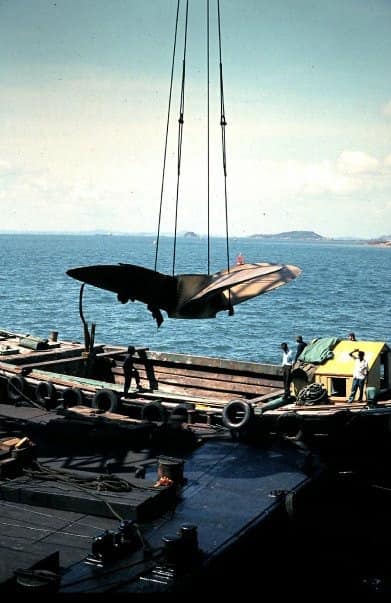
The shore side and quayside at Singapore was busy in a way that Westerners these days would not perhaps recognise, the water of the river brown with every kind of discarded detritus from foodstuff to waste, and the noise and smells around the narrow streets can only be imagined, from the fires and exotic dishes being hawked by street food traders to the paint used to refresh the ships hulls, and the paraffin’s and oils and the diverse cargoes of the ships themselves, Hemp, Palm Oil, livestock etc….. that, along with the smells of the river itself, must have been a heady assault on the nostrils until you managed to get a little further into Singapore town

It would not be until 1969, way after my father left Blue Funnel and his seafaring days behind, that Singapore’s Prime Minister Lee would begin to clean up the pollution of the Singapore River and the Kallang Basin, compelling the Bum-Boat owners and street traders to move from the estuary and its quays: “The government subsequently ruled that hawkers, squatters, makeshift industries (with the exception of the lighters), storehouses and others who made their living alongside the river, would have to be relocated in other areas as early as possible” (Cecilia Tortajada “Clean-up Of The Singapore River: Before And After” Online Resource https://lkyspp.nus.edu.sg/gia/article/clean-up-of-the-singapore-river-before-and-after Accessed: 07/02/2022)

I know my dad was a cinema fan, he often went to the movies and it was a particularly popular pastime with his generation so it is highly likely, as an engineering cadet (who’s hours of work would have been more lenient than say their more senior colleagues and qualified engineering staff), that he was able to get to the Cathay cinema and see a movie, as I am sure many of the crew of Dolius would have done before hitting the Hong Kong Bar or any of the multitude of other entertainments of Singapore in 1956. It may even be the case he got to see some of the film work going on in the area for the production of “A Town Like Alice”, the Nevil Shute novel filmed in part in Singapore and Penang, starring Virginia McKenna and Peter Finch, a tale of the Japanese invasion of Malaya and the brutal treatment of the British and Australians left behind by the evacuation process (Singapore film locations archive: “a town like alice (1956)” Online Resource: https://sgfilmlocations.com/2014/11/27/a-town-like-alice-1956/ Accessed 07/02/2022). Dolius was in Singapore twice on her maiden voyage, between 21st and 26th of Feb, when she was back in Penang at Port Swettenham, and between 29th of Feb and 10th March when she again left for Penang. By the time Engineering Cadet Ian Jones left the Malay Peninsular he would have been immersed and versed in the cultures of East Asia, and likely used to a hangover too…….

With the docks at Keppel Bay to her stern for the final time on this voyage, Dolius headed to Penang arriving there 12th March of 1956 and departing for Suez somewhere around the 20th March reaching Port Said on the 25th March. As I have already covered the area before on Helenus voyage of 1955, and in an effort not to bore anyone to death with the length of this piece I will (reluctantly) limit myself to looking at Dolius’ last port of call before she makes her way home to the Mersey estuary and Liverpool. Dolius departed Port Said for Gibraltar, arriving at noon on the 31st of March of 1956, it was a mere 26 days following the visit of the royal Yacht Britannia, and HRH Prince Philip, The Duke of Edinburgh, who had inspected the Guard of Honour of the Royal Marines on HMS Glasgow, amongst other duties that day

It was also that year that the Corps of Royal Engineers would hold a ceremony in the tunnels of the Rock, as Gibraltar is commonly known, to mark the centenary of their corps and to celebrate construction of “The Great North Road”, a mile long thoroughfare built to ensure soldiers and equipment could remain safe from Luftwaffe bombings during the Second World War. There are still covert posts being uncovered from that era, dug out and concealed for use by special operations squads should the rock have fallen into enemy hands, but long since forgotten until very recently, with equipment still in place, as if ready to use

Gibraltar is one of the most important British territories and has been since the Treaty of Utrecht in 1713, strategically located at the most Southern tip of Spain, at the “Pillars of Hercules”, the ancient name for the mouth of the Mediterranean Sea, where it sits directly opposite Morocco and Africa. There have been the usual contentions about the “sovereignty” of Gibraltar, as there have other British territories abroad, perhaps seen as “relics of Empire” by some? I look at things in a different way than most, there have been conquests across the globe for the whole of mankind’s existence, no one nation being less or more guilty than any other in reality, from the Han Chinese to the Umayyad Caliphate, the Mongols, Ottomans, Spanish, Egyptians, Romans, Greeks, Mesopotamians, Carthaginians, Persians, Mayans, Moors, Japanese, Austro-Hungarians or the Russians and Americans….etc! To me it is simple, if the people currently dominant in a place wish to remain tied to a particular nation, then that is what should continue until they decide otherwise…..all else is simply a hypocritical, covert land grabbing attempt, by those claiming sovereignty in the manner, variously of Argentina and Spain today (in respect to the Falkland Islands and Gibraltar)……but, luckily, I do not have to be anyone’s “politician” as the time I spent in the Diplomatic Corps were clearly, very much…. wasted years!

I cannot imagine anyone docking in Gibraltar, for no matter how short a time, who, besides a cold pint of Lager (insert your favourite beer/drink here), wouldn’t want to acquaint themselves with the ubiquitous “Rock Apes” of Gibraltar (No….Not the RAF Regiment, for those of you who served some time in HM forces….). The Barbary Macaque apes have made Gibraltar more famous than perhaps any other animal has managed in their native country, despite seemingly being an introduced species. The wild population of Macaques on Gibraltar were likely introduced by the North African Berber traders (“Barbary” is a derivative of “Berber”) before the British rule began and, apparently (Editorial: Wikipedia “Barbary macaques in Gibraltar” Online Resource: https://en.wikipedia.org/wiki/Barbary_macaques_in_Gibraltar Accessed: 08/02/2022), although it is “possible” they are remnants from a European population prior to the last ice-age, most believe that those became extinct 30,000 years ago. Macaques now number some 5 identified tribes on the Rock, and are increasing in numbers, going against the trend in their native North African population, which is declining. They are known and can be seen as resourceful and exceptionally cheeky with tourists, anyone spending a little time on YouTube can watch countless and amusing (for the observer, rather than the victim) incidents involving thievery and ingenuity from these beautiful but devious animals. They have even charmed royalty, in 1954 when HM Queen Elizabeth and HRH Prince Philip visited the Rock they spent time with the apes, there is nothing to note how that went, but I suppose even anarchic apes know when not to push their luck…..

Let’s assume Cadet Ian Jones got to see the Rock Apes of Gibraltar before Dolius up-anchored and left, why would he not have eh….? But the remaining mysteries of Gibraltar would still be there for another trip, whether that was the bars of the dock area or the military history of the Great North Road and the tunnels of the Royal Engineers, it would all still be there another day. Now it was time for Dolius to go home, Liverpool was calling and beyond that, after unloading there was Swansea and an inspection planned, time to check over Holt’s newest vessel and see that she was still Lloyd’s A+ fit…….And that is a tale for another day
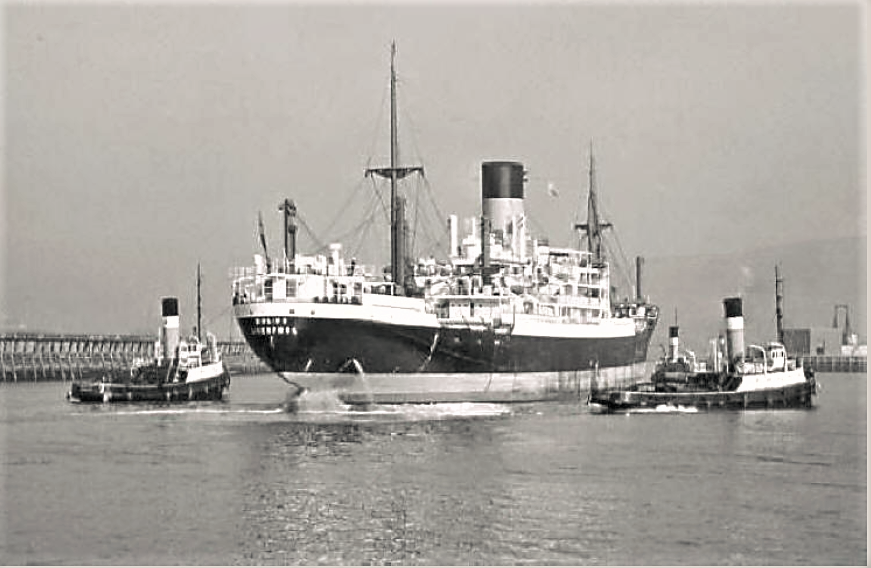

As always, I would like to sincerely thank those who made this piece possible, and without whose help it would have been a far far lesser read! Firstly the staff at the Liverpool Maritime Museum Archive for helping an idiot to research, and then for the kind use of their excellent photographs, Mr Andreas Hoppe, Mr Stephen Weir of the National Museums Northern Ireland, Mr John Shield, Mr Gwyn Jones, Mr Philip Braithwaite, Mr Ross Hopwood, Mr Georgie Marsh, Mr Ken Bolton & finally Mr Peter Cumberlidge

